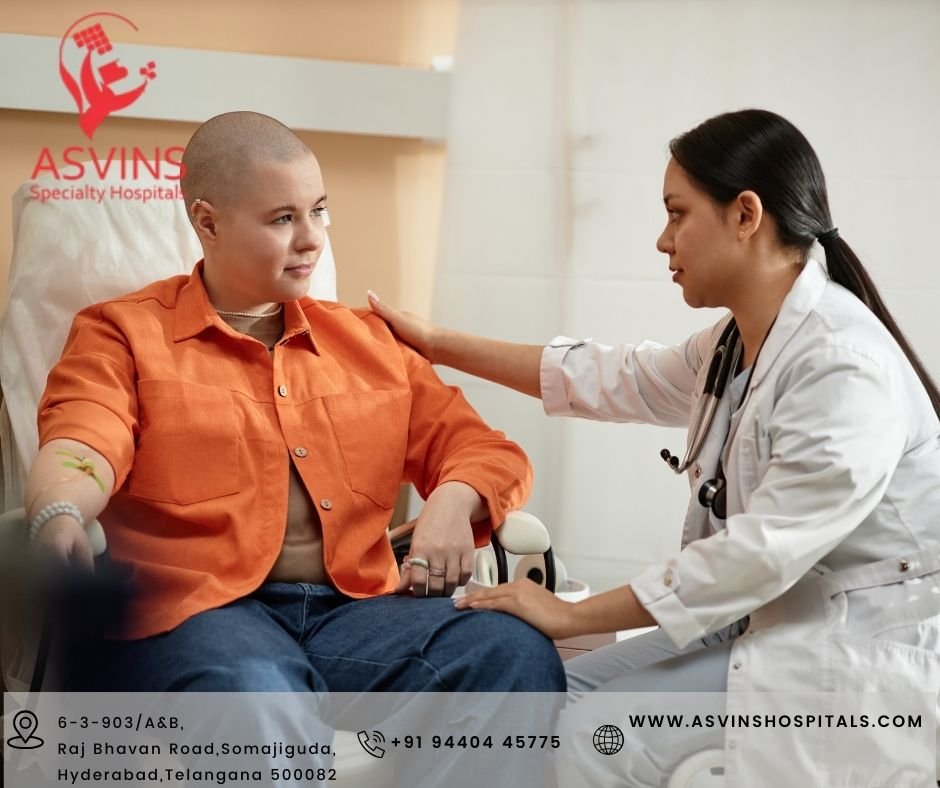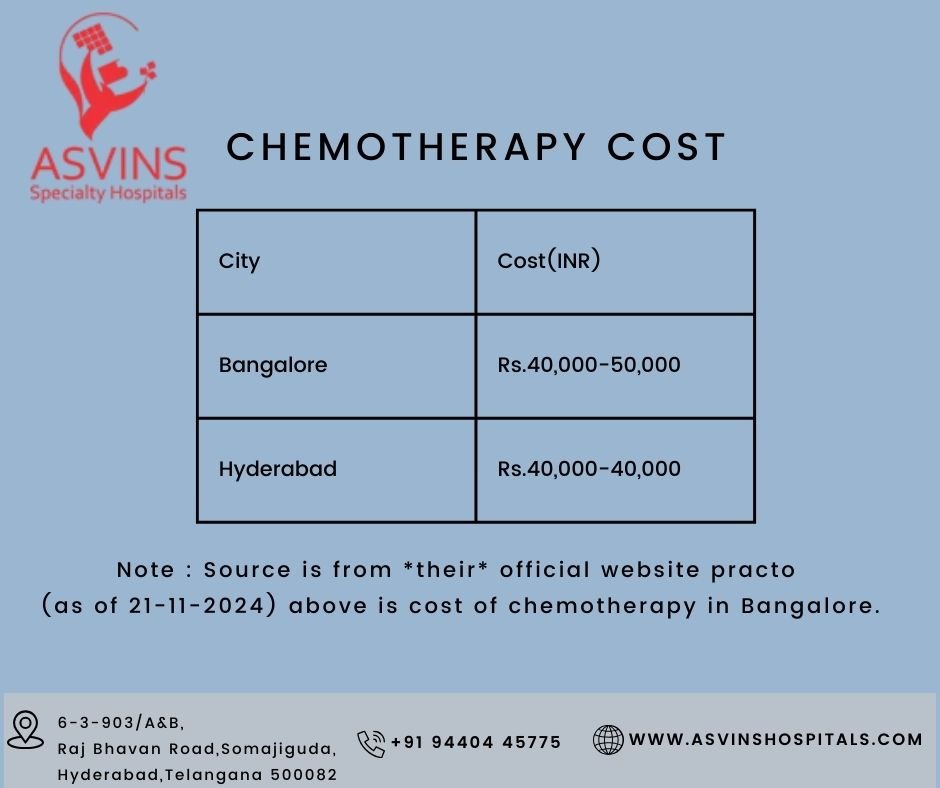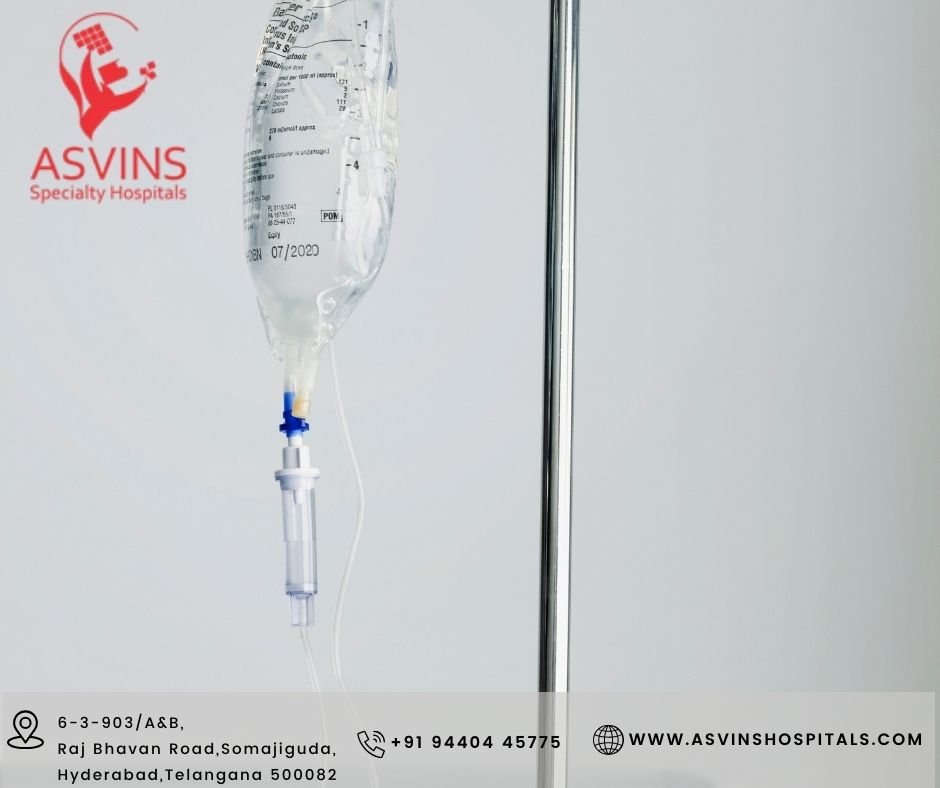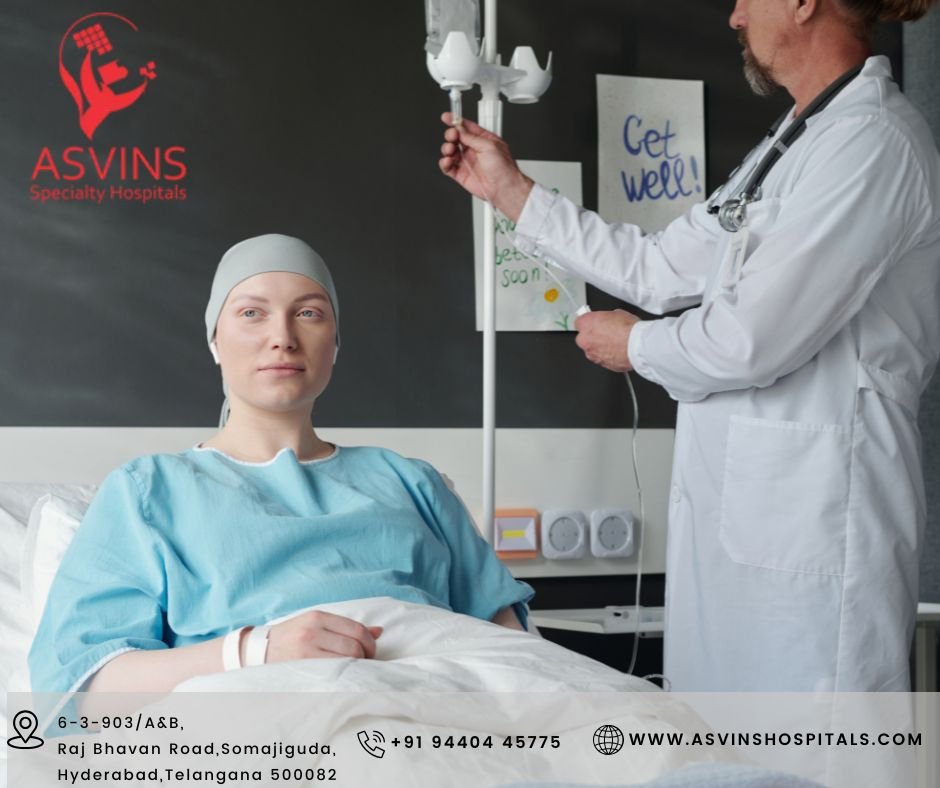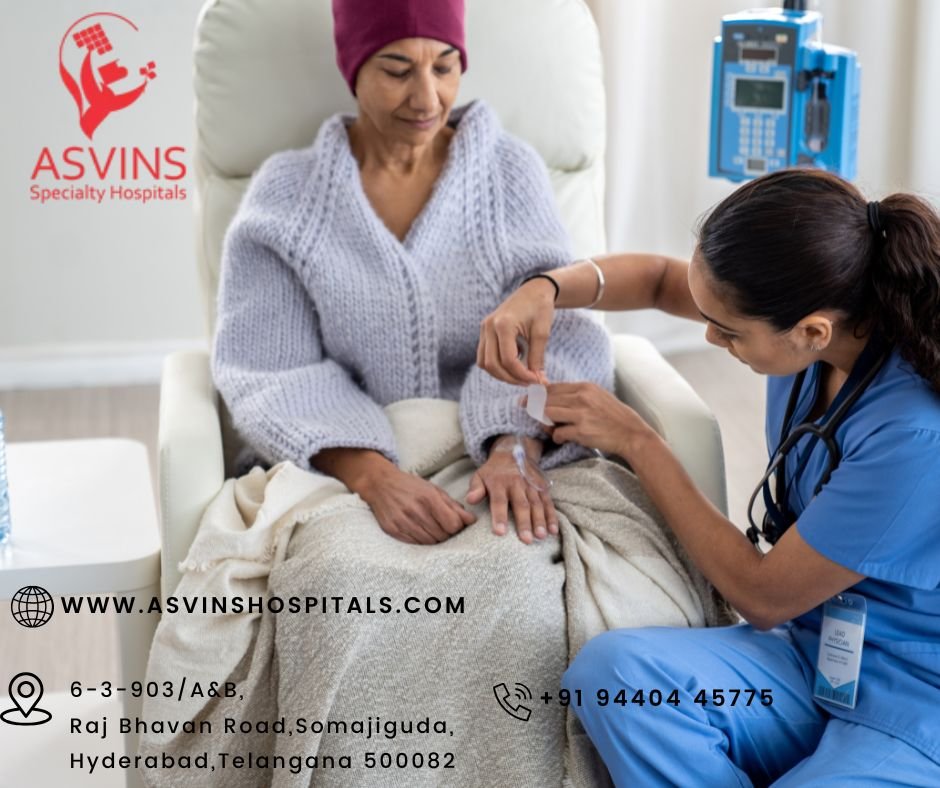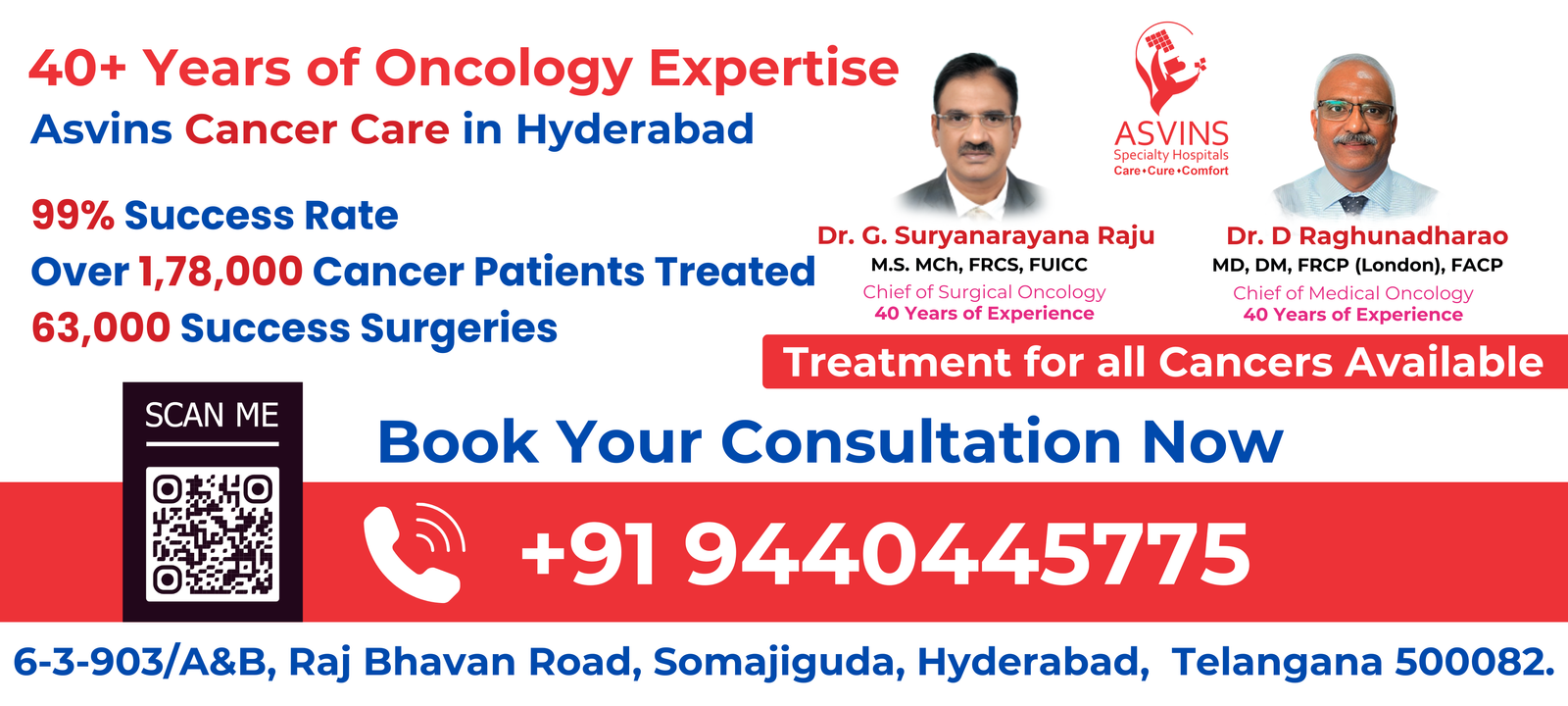Best Superspecialty Chemotherapy Treatment in Hyderabad, Telangana, India
1. What Is Meaning of Chemotherapy?
Chemotherapy is a type of cancer treatment used for treatment of a wide range of cancers. Chemotherapy is the treatment procedure that uses medicines to destroy cancer cells. Chemotherapy is used to treat many types of cancers. eg. Lung Cancer, Breast Cancer, Stomach & Liver Cancer, Prostate cancer. Chemotherapy is a comprehensive and powerful medical treatment designed to combat and control the growth of cancer cells within the body. The term “chemotherapy” is derived from the combination of two words: “chemicals” and “therapy.” Essentially, it involves the use of specific drugs, known as cytotoxic or antineoplastic agents, to target and destroy cancer cells. The primary objective of chemotherapy is to impede the rapid division and growth of these abnormal cells.
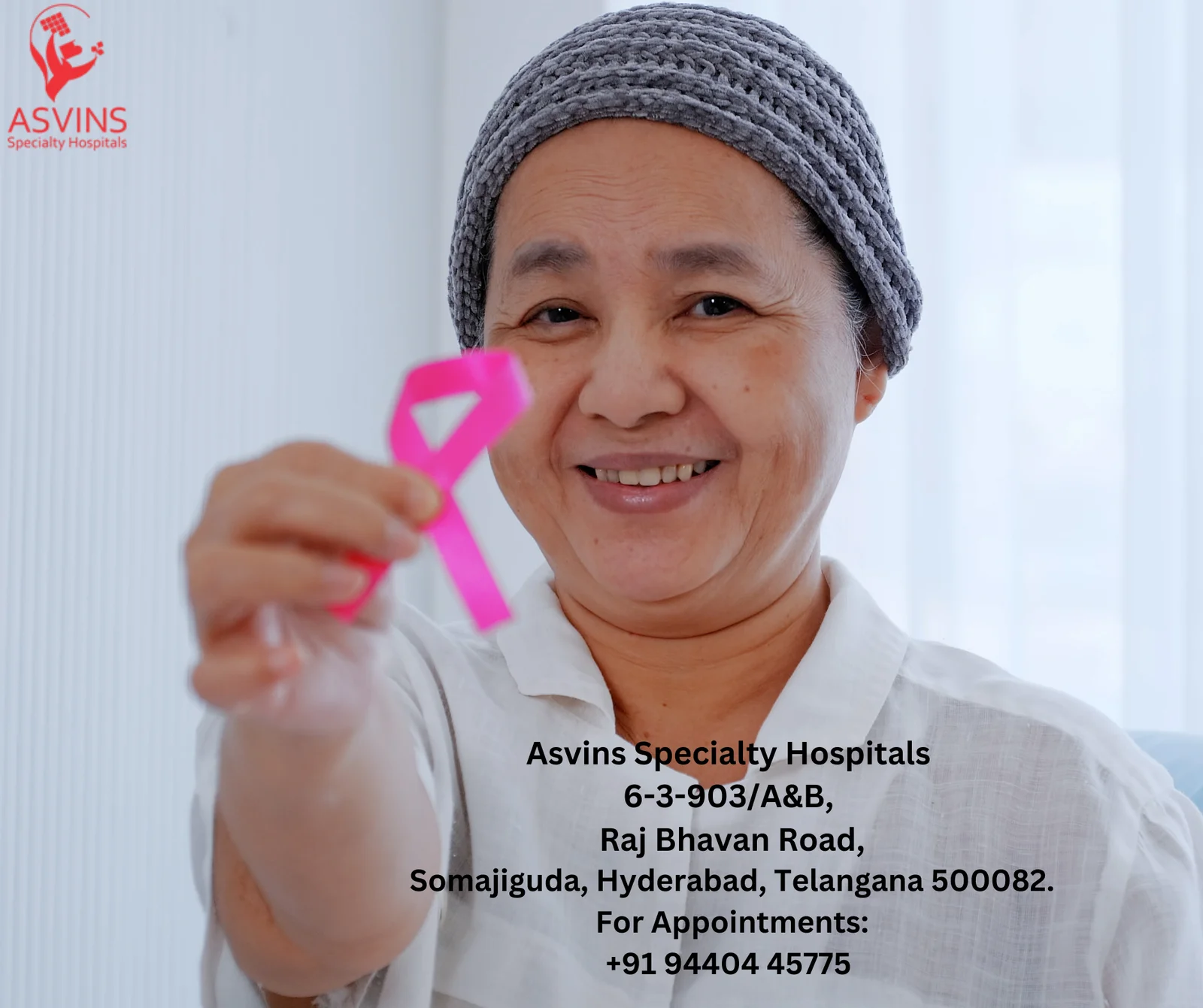
These drugs are administered through various methods, including intravenous injections, oral medications, or topical applications, depending on the type of cancer and its stage. Chemotherapy works by disrupting the cell cycle, preventing cancer cells from dividing and multiplying. While its primary focus is on cancer cells, chemotherapy may also affect normal, healthy cells that divide rapidly, such as those in the bone marrow, hair follicles, and the lining of the digestive tract.
Despite potential side effects, chemotherapy has proven to be a crucial component in the treatment of various cancers, either as a standalone therapy or in conjunction with surgery, radiation, or other targeted treatments. The goal is to eliminate or shrink tumors, prevent the spread of cancer, and improve overall patient outcomes. Medical professionals carefully tailor chemotherapy regimens to individual patients based on the type and stage of cancer, as well as their overall health.
2. What Are Side Effects of Chemotherapy & Chemotherapy Drugs?
Side Effects may include Mouth sores, Fatigue Nausea, vomiting, Pain, Hair loss Chemotherapy is a widely used treatment for cancer, employing powerful drugs to target and destroy rapidly dividing cancer cells. While this approach is effective in fighting cancer, it can also bring about various side effects due to its impact on normal, healthy cells. The side effects of chemotherapy can vary widely from person to person and depend on the specific drugs used, the dosage, and the duration of treatment.
Chemo treatment drugs can affect the bone marrow, leading to a decrease in red and white blood cells, causing anemia and an increased risk of infection. Additionally, patients may experience changes in appetite, taste, and weight. Gastrointestinal issues such as diarrhea or constipation are also common.
Chemotherapy can impact the lining of the digestive tract, leading to mouth sores and increased susceptibility to infections. Some drugs may affect nerve cells, resulting in peripheral neuropathy, characterized by tingling, numbness, or pain in the hands and feet.
It’s important to note that advancements in medical research continually strive to minimize these side effects, and healthcare providers often employ supportive therapies to manage and alleviate discomfort. Patients undergoing chemo treatment should maintain open communication with their healthcare team to address and manage potential side effects effectively.
3. What Are Chemotherapy Drugs and Medicine?
Chemotherapy drugs, also known as antineoplastic or cytotoxic agents, are medications specifically designed to combat and destroy cancer cells. These drugs interfere with the cell cycle, disrupting the process of cell division and preventing the uncontrolled growth characteristic of cancer. Chemotherapy may be administered as part of a comprehensive cancer treatment plan, either alone or in combination with surgery, radiation therapy, or other targeted therapies.
There are various types of chemotherapy drugs, each with distinct mechanisms of action and specific targets within the cancer cell. Some drugs inhibit DNA replication, preventing the cancer cell from reproducing, while others interfere with protein synthesis or disrupt the cell’s internal structure.
Chemotherapy drugs can be administered through different routes, including intravenous injections, oral pills, or topical applications, depending on the type and stage of cancer. The choice of drugs and their combination in a treatment regimen is carefully determined by oncologists based on the specific characteristics of the cancer and the patient’s overall health.
While these drugs are powerful in their ability to combat cancer, they may also affect healthy, rapidly dividing cells in the body, leading to side effects such as nausea, fatigue, and hair loss. The selection and management of chemotherapy drugs are crucial aspects of cancer care, requiring close collaboration between patients and their healthcare teams to optimize treatment outcomes.
4. What Is Cost of Chemotherapy?
The cost of chemotherapy can vary widely depending on several factors, making it challenging to provide a one-size-fits-all estimate. Several elements contribute to the overall expense of chemotherapy, including the type and stage of cancer, the specific chemotherapy drugs prescribed, the duration of treatment, and the mode of administration.

In many cases, chemotherapy costs include not only the drugs themselves but also associated expenses such as medical tests, clinic visits, and potential hospital stays. Additionally, the frequency of treatments and the need for supportive medications to manage side effects contribute to the overall financial burden.
Health insurance coverage plays a significant role in mitigating the cost of chemotherapy for many patients. Coverage varies among insurance plans, and patients are advised to thoroughly review their policies to understand what expenses are covered and what out-of-pocket costs they may incur.
For those without insurance or facing high out-of-pocket expenses, financial assistance programs, pharmaceutical company assistance programs, and non-profit organizations may offer support. It’s crucial for individuals undergoing chemotherapy to communicate openly with their healthcare providers and financial counselors to explore available resources and develop a plan to manage the financial aspects of their treatment.
5. Other Expenses Involved in Chemo Treatment ?
Beyond the direct cost of Chemo Treatment drugs, there are additional expenses associated with undergoing this cancer treatment. These ancillary costs can impact the overall financial burden on patients and should be considered when planning for Chemo Treatment.
Medical Tests: Chemo Treatment often requires regular medical tests to monitor the progress of treatment and assess the patient’s overall health. These tests may include blood work, imaging studies, and other diagnostic procedures.
Clinic Visits: Patients undergoing Chemo Treatment typically need to visit the clinic or hospital regularly for treatment sessions and medical evaluations. Transportation costs, parking fees, and potential accommodation expenses become part of the overall expenditure.
Supportive Medications: Managing side effects is a crucial aspect of Chemo Treatment, and patients may need additional medications to alleviate symptoms such as nausea, pain, or infections. The cost of these supportive drugs adds to the overall financial impact.
Hospital Stays: In some cases, Chemo Treatment may require hospitalization, leading to additional expenses related to room charges, nursing care, and other hospital services.
Home Care: Patients may require home care services or medical equipment to manage the effects of Chemo Treatment, contributing to the overall cost of treatment.
It’s important for individuals undergoing Chemo Treatment to discuss these potential expenses with their healthcare providers and financial counselors. Exploring available resources, financial assistance programs, and seeking support from nonprofit organizations can help alleviate the financial strain associated with Chemo Treatment and ensure that patients can focus on their health and well-being during this challenging time.
6. Chemo Treatment Treatment Cost or Price in India ?
In India, the cost of Chemo Treatment treatment can vary widely based on several factors, including the type of cancer, the stage of the disease, the specific Chemo Treatment drugs prescribed, and the duration of treatment. Public and private healthcare facilities may have different pricing structures, and geographical location can also influence costs.
Government hospitals and cancer treatment centers in India often provide subsidized or more affordable Chemo Treatment options, making healthcare accessible to a broader population. Private hospitals, on the other hand, may offer more specialized services but at a higher cost.
The type of Chemo Treatment drugs used significantly impacts the overall expenses. Generic drugs are generally more cost-effective than their branded counterparts, and some hospitals may provide financial assistance or discounts on medications.
It’s important to note that health insurance coverage can significantly alleviate the financial burden for individuals undergoing Chemo Treatment. Patients are advised to carefully review their insurance policies to understand coverage details, including drug costs, diagnostic tests, and hospitalization.
While the cost of Chemo Treatment treatment in India is generally more affordable compared to many Western countries, it remains a significant investment. Seeking guidance from healthcare providers, exploring available financial assistance programs, and discussing payment plans can help individuals and their families manage the financial aspects of Chemo Treatment while prioritizing effective cancer treatment.
7. Is Chemo Treatment Treatment a Cure for Cancer ?
Chemo Treatment is a potent and widely used treatment for cancer, but it’s important to understand that its primary goal is to control, manage, or eliminate cancer cells rather than guarantee an absolute cure in all cases. Whether Chemo Treatment serves as a cure depends on various factors, including the type and stage of cancer, the responsiveness of the cancer cells to the drugs, and the overall health of the patient.
In some instances, Chemo Treatment can indeed lead to a complete remission, where all signs of cancer disappear, and the patient is considered cured. This is more common in certain types of leukemia and lymphoma.
However, for many solid tumors, the goal of Chemo Treatment may be to shrink the tumor, prevent its spread, or make it more amenable to surgical removal or other targeted treatments. In these cases, the term “cure” may not be applicable, but Chemo Treatment becomes an essential component of a multi-modal treatment plan aimed at prolonging and improving the patient’s life.
Chemo Treatment is often used in conjunction with surgery, radiation therapy, and other treatments to create a comprehensive and personalized approach to cancer care. Advances in research and the development of targeted therapies continue to improve the effectiveness of Chemo Treatment, offering better outcomes and increased chances of long-term remission for many cancer patients.
8. What Is Procedure for Chemotherapy ?
The procedure for chemotherapy involves a systematic and personalized approach to administering potent anti-cancer drugs to patients. The specific steps may vary depending on the type of cancer, the drugs prescribed, and the individual’s overall health. Here is a general overview of the procedure for chemotherapy:
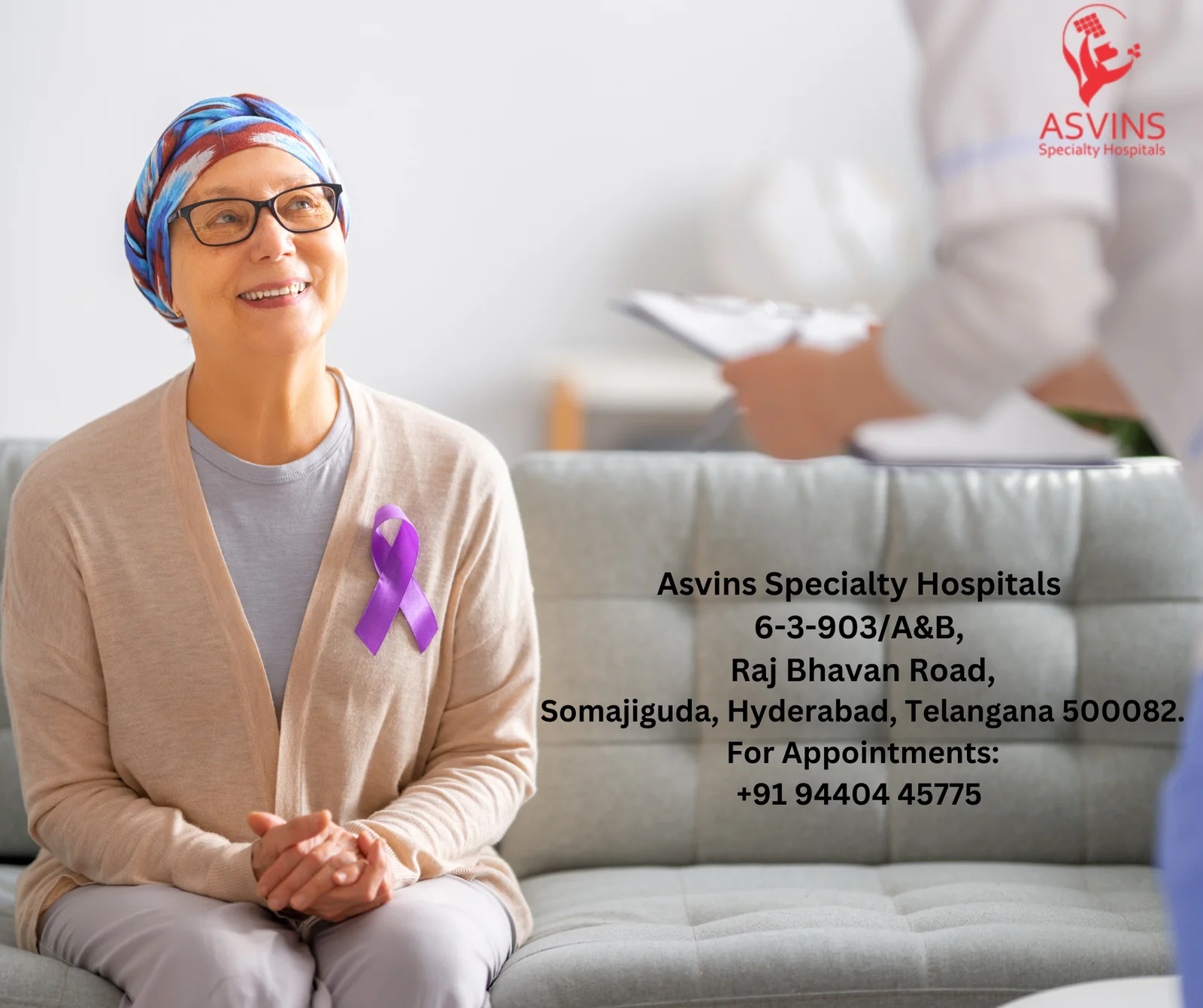
Assessment and Consultation: Before starting chemotherapy, the oncologist conducts a thorough assessment, including reviewing medical history, performing physical examinations, and conducting diagnostic tests to determine the type and stage of cancer.
Treatment Planning: Based on the assessment, the oncologist develops a treatment plan that outlines the type of chemotherapy drugs, dosage, frequency of treatment, and the overall duration of the therapy.
Accessing Veins: Chemotherapy drugs are commonly administered intravenously. A small tube, known as a catheter or IV line, is inserted into a vein, often in the arm or hand. This allows direct access for drug delivery and minimizes discomfort for the patient.
Drug Administration: Chemotherapy drugs can be delivered through various methods, including injections, infusions, or oral medications. The process can take place in a hospital setting, clinic, or even at home, depending on the prescribed regimen.
Monitoring and Support: During and after the chemotherapy session, patients are closely monitored for any adverse reactions or side effects. Supportive care, such as medications to manage side effects, may be provided.
Follow-up Appointments: Chemotherapy is often administered in cycles, with breaks between treatments to allow the body to recover. Follow-up appointments are scheduled to assess treatment response, adjust the treatment plan if necessary, and address any concerns the patient may have.
Throughout the procedure, clear communication between the patient and healthcare team is crucial to managing potential side effects and ensuring the effectiveness of the chemotherapy treatment.
9. What Are Different Chemotherapy Types ?
Chemotherapy encompasses various types, each designed to target specific aspects of cancer cells’ growth and division. The choice of chemotherapy type depends on the type of cancer, its stage, and the patient’s overall health. Here are some common chemotherapy types:
Alkylating Agents: These drugs interfere with cancer cell DNA, preventing their ability to replicate. Examples include cyclophosphamide and cisplatin.
Antimetabolites: These drugs disrupt the cancer cell’s ability to utilize nutrients, hindering DNA and RNA synthesis. Methotrexate and fluorouracil are examples of antimetabolites.
Anthracyclines: These drugs, such as doxorubicin, act by inhibiting DNA and RNA synthesis and can be effective against a variety of cancers, including breast and lung cancers.
Topoisomerase Inhibitors: Drugs like etoposide and irinotecan target enzymes involved in DNA replication, causing breaks in the DNA strands.
Mitotic Inhibitors: These drugs interfere with the process of cell division. Paclitaxel and docetaxel are examples that prevent the formation of the spindle fibers needed for cell division.
Targeted Therapies: These drugs specifically target certain molecules or pathways involved in cancer growth. Examples include tyrosine kinase inhibitors and monoclonal antibodies.
Hormone Therapy: Used for hormone-sensitive cancers, such as breast and prostate cancers, hormone therapy aims to block or inhibit the effects of hormones that fuel cancer growth.
The combination of these chemotherapy types in a treatment regimen is common, known as combination chemotherapy, to enhance effectiveness and reduce the risk of drug resistance. The oncologist carefully selects the most appropriate chemotherapy types based on the individual characteristics of the cancer and the patient’s overall health.
10. Any Alternative for Chemotherapy Treatment Process?
While chemotherapy is a standard and effective treatment for cancer, there are alternative or complementary therapies that some individuals explore. It’s important to note that alternative treatments should be discussed thoroughly with healthcare providers, and they are not meant to replace conventional cancer treatments. Here are some alternative approaches that some patients consider:
Immunotherapy: Chemotherapy treatment harnesses the body’s immune system to target and destroy cancer cells. It has shown promising results in various cancers, providing an alternative or complementary option to chemotherapy.
Targeted Therapies: These drugs specifically target molecules or pathways involved in cancer growth, minimizing damage to healthy cells. They are often used alongside or as an alternative to chemotherapy.
Hormone Therapy: For hormone-sensitive cancers like breast and prostate cancer, hormone therapy aims to disrupt the hormonal signals fueling cancer growth.
Hyperthermia: This involves raising the temperature of the affected body part to enhance the effectiveness of radiation or other cancer treatments.
Photodynamic Therapy: This involves the use of light-activated drugs to kill cancer cells.
Mind-Body Techniques: Practices such as meditation, yoga, and acupuncture are explored by some individuals to manage cancer-related symptoms and improve overall well-being.
It’s crucial for individuals considering alternative therapies to have open communication with their healthcare team. While some alternative approaches may provide symptom relief or support, they are not proven substitutes for established treatments like chemotherapy in terms of targeting and eliminating cancer cells. Every patient’s situation is unique, and treatment decisions should be based on thorough discussions with qualified healthcare professionals.
11. How Chemotherapy Is Done ?
Chemotherapy is administered through a systematic process that involves careful planning and personalized care. The steps involved in how chemotherapy is done may vary depending on the type of cancer, the specific drugs prescribed, and the patient’s overall health. Here is a general overview of how chemotherapy is typically conducted:
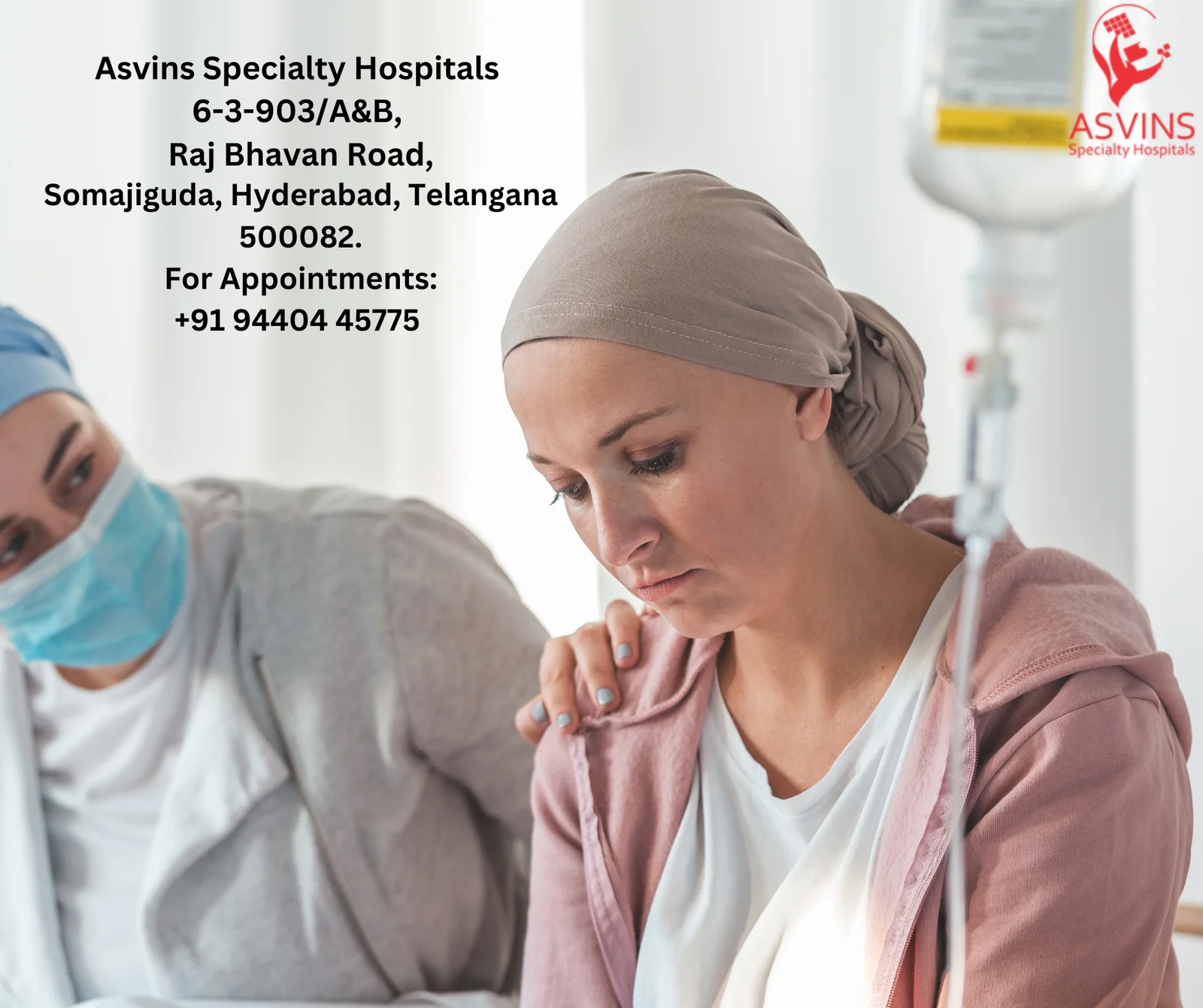
Assessment and Consultation: Before initiating chemotherapy, the oncologist conducts a thorough assessment, reviewing the patient’s medical history, performing physical examinations, and conducting diagnostic tests to determine the type and stage of cancer.
Treatment Planning: Based on the assessment, the oncologist develops a treatment plan, outlining the type of chemotherapy drugs, dosage, frequency of treatment, and the overall duration of the therapy.
Accessing Veins: Most commonly, chemotherapy drugs are administered intravenously. A catheter or IV line is inserted into a vein, providing direct access for drug delivery and minimizing discomfort for the patient.
Drug Administration: Chemotherapy drugs can be delivered through various methods, including injections, infusions, or oral medications. The process may take place in a hospital setting, clinic, or even at home, depending on the prescribed regimen.
Monitoring and Support: During and after the chemotherapy session, patients are closely monitored for any adverse reactions or side effects. Supportive care, such as medications to manage side effects, may be provided.
Follow-up Appointments: Chemotherapy is often administered in cycles, with breaks between treatments to allow the body to recover. Follow-up appointments are scheduled to assess treatment response, adjust the treatment plan if necessary, and address any concerns the patient may have.
Throughout the process, clear communication between the patient and healthcare team is essential to manage potential side effects effectively and ensure the overall success of the chemotherapy treatment.
12. Is Chemotherapy Effective for Breast Cancer ?
Chemotherapy is often an effective and integral component of the treatment plan for breast cancer. Its effectiveness depends on several factors, including the type and stage of breast cancer, the presence of specific receptors on the cancer cells, and the overall health of the patient.
For certain types of breast cancer, such as triple-negative breast cancer or HER2-positive breast cancer, chemotherapy may be a primary treatment modality. It is particularly valuable in targeting rapidly dividing cancer cells throughout the body, including those that may have spread beyond the breast.
In cases where the breast cancer is hormone receptor-positive, meaning it is influenced by estrogen or progesterone, hormone therapy may be the primary treatment, but chemotherapy might also be recommended in certain situations. This combination approach aims to maximize the effectiveness of treatment and reduce the risk of recurrence.
Chemotherapy can be administered before surgery (neoadjuvant) to shrink tumors, after surgery (adjuvant) to eliminate any remaining cancer cells, or as a palliative measure for advanced or metastatic breast cancer.
While chemotherapy can be associated with side effects, advancements in medical research and personalized treatment plans have contributed to minimizing these effects and optimizing outcomes. The decision to use chemotherapy is based on a comprehensive assessment by the oncologist, considering the specific characteristics of the breast cancer and tailoring the treatment to each patient.
13. Is Chemotherapy Is Painful ?
The experience of pain during chemotherapy can vary widely among individuals, and it’s essential to recognize that not everyone undergoing chemotherapy will necessarily experience pain. However, certain aspects of the treatment process may cause discomfort or pain for some patients.

Administration Process: The actual administration of chemotherapy drugs, especially through intravenous (IV) injections or infusions, may cause temporary discomfort at the injection site. The sensation can range from mild discomfort to a brief stinging feeling.
Side Effects: Chemotherapy commonly induces side effects, and some of these, such as muscle aches, joint pain, or headaches, may contribute to overall discomfort. Gastrointestinal symptoms like nausea and abdominal pain can also occur.
Peripheral Neuropathy: Some chemotherapy drugs can cause peripheral neuropathy, characterized by tingling, numbness, or pain in the hands and feet. This can be a source of discomfort for some patients.
Mucositis: Chemotherapy’s impact on rapidly dividing cells can lead to inflammation and sores in the mucous membranes of the mouth and throat, causing pain and difficulty in swallowing.
It’s crucial to note that healthcare providers prioritize managing and alleviating pain associated with chemotherapy. They may prescribe medications to help control pain and other side effects, and patients are encouraged to communicate openly with their healthcare team to ensure that any discomfort is promptly addressed. Advances in supportive care have significantly improved the overall experience for many individuals undergoing chemotherapy.
14. Precautions to Be Taken After Chemotherapy of Breast Cancer ?
After undergoing chemotherapy for breast cancer, patients should take certain precautions to promote their overall well-being and facilitate the recovery process. Here are some important precautions to consider:
Infection Prevention: Chemotherapy can temporarily weaken the immune system. Patients should practice good hygiene, including regular handwashing, and avoid close contact with individuals who are sick. It’s also advisable to steer clear of crowded places to minimize the risk of infections.
Nutrition and Hydration: Maintaining a healthy diet is crucial for recovery. A well-balanced diet rich in nutrients can help rebuild strength and support the immune system. Staying hydrated is equally important, so patients should drink an adequate amount of water daily.
Rest and Fatigue Management: Chemotherapy often causes fatigue. Adequate rest is essential for recovery. Patients should listen to their bodies, prioritize sleep, and avoid overexertion. Incorporating gentle exercises, such as walking, can help combat fatigue without causing strain.
Medication Adherence: Patients are often prescribed medications to manage side effects or support recovery. It’s important to take medications as prescribed and to communicate any concerns or side effects to the healthcare team.
Monitoring Side Effects: Regularly monitoring for potential side effects, such as changes in blood counts, nausea, or signs of infection, is crucial. Promptly reporting any unusual symptoms to the healthcare team allows for timely intervention.
Emotional Support: Breast cancer treatment can be emotionally challenging. Seeking support from friends, family, or support groups, and discussing concerns with healthcare providers or counselors can contribute to emotional well-being.
Individuals should follow the specific guidelines provided by their healthcare team, as the precautions may vary based on the type of chemotherapy received and individual health considerations. Open communication with the healthcare team ensures that personalized advice is provided to support a smoother recovery journey.
15. Is Chemotherapy Available in Injection Form ?
Yes, chemotherapy is available in injection form, and intravenous (IV) administration is one of the common methods for delivering chemotherapy drugs. In this approach, the drugs are introduced directly into a vein, allowing for a rapid and efficient distribution throughout the body. Intravenous chemotherapy may be administered through a catheter, which is a thin tube inserted into a vein, providing a secure and convenient access point for repeated treatments.
The choice of injection form depends on the specific chemotherapy drugs prescribed, the type of cancer being treated, and the individual patient’s treatment plan. While IV injections are a common method, chemotherapy drugs can also be administered through intramuscular (IM) injections or subcutaneous (under the skin) injections in certain cases.
The form of injection is determined based on factors such as the drug’s properties, the desired treatment outcome, and considerations for the patient’s comfort and convenience. Healthcare providers carefully assess these factors when designing a chemotherapy treatment plan tailored to the individual needs of the patient.
It’s important for patients to discuss the administration method with their healthcare team, as they will provide guidance on the most appropriate and effective approach for delivering chemotherapy based on the specific circumstances of the cancer and the patient’s overall health.
16. What Is the Difference Between Chemotherapy and Radiation(Radiotherapy) ?
Chemotherapy and radiation therapy (radiotherapy) are both common treatments for cancer, but they differ in their mechanisms, targets, and administration methods.
Chemotherapy:
Mechanism: Chemotherapy involves the use of drugs that circulate throughout the body, reaching cancer cells wherever they may be. It is a systemic treatment.
Targets: Chemotherapy targets rapidly dividing cells, both cancerous and some healthy cells, affecting various parts of the body.
Administration: Administered through intravenous injections, oral medications, or other methods, chemotherapy can treat cancers that have spread to different parts of the body.
Radiation Therapy:
Mechanism: Radiation therapy uses high doses of radiation to target and kill cancer cells. It is a localized treatment.
Targets: Radiation is precisely directed at the specific area of the body where the tumor is located, minimizing damage to surrounding healthy tissue.
Administration: Typically delivered externally through a machine (external beam radiation), or internally through implants (brachytherapy), radiation therapy is focused on a specific region where the cancer is situated.
While chemotherapy and radiation therapy can be used independently, they are often combined to enhance treatment effectiveness, especially in cases where cancer has both a primary tumor and has spread to other parts of the body. The choice between the two or a combination depends on factors such as the type and stage of cancer, overall health, and treatment goals.
17. What Are Chemotherapy Agents ?
Chemotherapy agents, also known as antineoplastic or cytotoxic drugs, are medications specifically designed to inhibit or destroy rapidly dividing cancer cells. These drugs are a crucial component of cancer treatment and can be administered through various methods, including intravenous injections, oral pills, or topical applications.
Chemotherapy agents work by disrupting the cell cycle of cancer cells, preventing their ability to divide and proliferate. While they primarily target cancer cells, these drugs may also affect normal, healthy cells that undergo rapid division, leading to side effects. The specific chemotherapy agents chosen for a patient’s treatment plan depend on factors such as the type and stage of cancer, the patient’s overall health, and the desired treatment outcome.
There are several classes of chemotherapy agents, each with its own mechanism of action. Examples include:
Alkylating Agents: Interfere with DNA replication, preventing cell division (e.g., cyclophosphamide).
Antimetabolites: Disrupt the cancer cell’s ability to use nutrients for DNA and RNA synthesis (e.g., methotrexate).
Topoisomerase Inhibitors: Target enzymes involved in DNA replication, causing breaks in DNA strands (e.g., etoposide).
Mitotic Inhibitors: Disrupt the process of cell division (e.g., paclitaxel).
Targeted Therapies: Specifically target molecules or pathways involved in cancer growth (e.g., tyrosine kinase inhibitors).
The selection and combination of chemotherapy agents are carefully determined by oncologists based on the characteristics of the cancer and the individual patient’s treatment plan.
18. Do Chemotherapy Tablets Be Used Under Doctor Supervision Only ?
Yes, the use of chemotherapy tablets, like other forms of chemotherapy, should be conducted under the supervision and guidance of a qualified healthcare professional, typically an oncologist. Chemotherapy medications, whether in tablet, capsule, or liquid form, are potent and come with potential side effects that require careful monitoring and management.
Here are some reasons why chemotherapy tablets should be used under doctor supervision:
Dosing and Schedule: The oncologist determines the appropriate dosage and treatment schedule based on factors such as the type and stage of cancer, the patient’s overall health, and treatment goals. Proper dosing is crucial for the effectiveness of the treatment and to minimize side effects.
Monitoring Side Effects: Chemotherapy can cause a range of side effects, and healthcare professionals closely monitor patients for any adverse reactions. Regular check-ups and communication with the healthcare team help identify and manage side effects promptly.
Adjustments and Modifications: If a patient experiences significant side effects or if there are changes in their health status, the oncologist may need to adjust the treatment plan. This can include modifying the dosage, changing the medication, or temporarily halting treatment.
Comprehensive Care: Chemotherapy is often part of a comprehensive cancer treatment plan, which may include surgery, radiation, or other therapies. Coordinating these treatments requires oversight by healthcare professionals to ensure the best possible outcomes.
Self-administering chemotherapy tablets without proper medical guidance can lead to serious consequences, including ineffective treatment, increased side effects, or even potential harm. It’s essential for patients to follow their oncologist’s recommendations and maintain open communication throughout the treatment process.
19. Can Chemo Treatment Cure Cancer / Will Chemo Treatment Cure Cancer ?
While Chemo Treatment is a powerful and widely used treatment for cancer, whether it can cure cancer depends on various factors, including the type and stage of cancer, the responsiveness of the cancer cells to the drugs, and the overall health of the patient.
In some cases, Chemo Treatment can lead to a complete remission, where all signs of cancer disappear, and the patient is considered cured. This outcome is more common in certain types of leukemia and lymphoma.
However, for many solid tumors, the goal of Chemo Treatment may be to shrink the tumor, prevent its spread, or make it more amenable to surgical removal. In these cases, the term “cure” may not be applicable, but Chemo Treatment becomes an essential component of a comprehensive treatment plan aimed at prolonging and improving the patient’s life.
Chemo Treatment is often used in conjunction with surgery, radiation therapy, and other targeted treatments to create a comprehensive and personalized approach to cancer care. Advances in medical research and the development of targeted therapies continue to improve the effectiveness of Chemo Treatment, offering better outcomes and increased chances of long-term remission for many cancer patients. It’s essential for individuals to discuss their specific situation with their healthcare team to understand the goals and expectations of Chemo Treatment in their particular case.
20. How Chemo Treatment Treatment Is Applied for Lung Cancer ?
Chemo Treatment is a common and effective treatment modality for lung cancer, and its application depends on several factors such as the type and stage of lung cancer, the overall health of the patient, and the treatment goals. Here is an overview of how Chemo Treatment is typically applied for lung cancer:
Type of Lung Cancer: Chemo Treatment may be used for both small cell lung cancer (SCLC) and non-small cell lung cancer (NSCLC). The specific Chemo Treatment drugs and regimen will vary based on the type and characteristics of the cancer.
Treatment Stages: Chemo Treatment can be administered at different stages of lung cancer treatment. It may be used before surgery to shrink tumors (neoadjuvant), after surgery to eliminate residual cancer cells (adjuvant), or as the primary treatment for advanced or metastatic lung cancer.
Combination Therapy: Often, Chemo Treatment for lung cancer involves a combination of drugs to enhance effectiveness. The oncologist carefully selects the drugs and tailors the treatment plan to the individual patient’s needs.
Administration Method: Chemo Treatment can be administered intravenously (IV) through injections or infusions, orally in the form of pills or capsules, or a combination of both. The chosen method depends on the specific drugs and the treatment plan.
Side Effect Management: Chemo Treatment for lung cancer can be associated with side effects such as nausea, fatigue, and decreased blood cell counts. Supportive care, including medications and lifestyle adjustments, is integrated into the treatment plan to manage these side effects.
The goal of Chemo Treatment in lung cancer is to target and destroy cancer cells while minimizing damage to healthy cells. The application of Chemo Treatment is part of a comprehensive treatment strategy that may also include surgery, radiation therapy, and other therapies, with the aim of improving patient outcomes and overall quality of life.
21. What Are Chemo Treatment Complications ?
Chemo Treatment, while a powerful cancer treatment, can be associated with various complications and side effects. The nature and severity of these complications can vary among individuals and depend on factors such as the type and stage of cancer, the specific Chemo Treatment drugs used, and the overall health of the patient. Some common Chemo Treatment complications include:
Nausea and Vomiting: Many Chemo Treatment drugs can cause nausea and vomiting.
Fatigue: Cancer-related fatigue is a common complication of Chemo Treatment, leading to a persistent feeling of tiredness and reduced energy levels.
Weakened Immune System: Chemo Treatment can suppress the bone marrow, leading to a decrease in white blood cell counts and an increased risk of infections.
Hair Loss: Certain Chemo Treatment drugs may cause hair loss, affecting the scalp, body, and even eyelashes and eyebrows.
Anemia: Chemo Treatment can reduce red blood cell counts, leading to anemia, which can result in fatigue, weakness, and shortness of breath.
Peripheral Neuropathy: Some Chemo Treatment drugs may cause damage to peripheral nerves, resulting in symptoms like tingling, numbness, and pain in the hands and feet.
Mucositis: Inflammation and sores in the mucous membranes of the mouth and throat can cause pain and difficulty in swallowing.
Organ Toxicity: Certain Chemo Treatment drugs may impact the function of organs such as the heart, liver, or kidneys, leading to potential complications.
It’s crucial for healthcare providers to monitor and manage these complications, adjusting the treatment plan as needed to minimize adverse effects and enhance the overall well-being of the patient undergoing Chemo Treatment. Open communication between patients and their healthcare team is vital for addressing and mitigating these challenges effectively.
22. How Chemotherapy Is Given ?
Chemotherapy is administered in various ways, and the chosen method depends on factors such as the type of cancer, the specific chemotherapy drugs prescribed, and the overall health of the patient. Here are the common methods through which chemotherapy is given:

Intravenous (IV) Administration: This is the most common method where chemotherapy drugs are delivered directly into a vein. The drugs can be given as a quick injection or as a continuous infusion over a longer period.
Oral Medications: Some chemotherapy drugs are available in pill, capsule, or liquid form and can be taken by mouth. This method allows for more flexibility, as patients can take their medication at home.
Intramuscular (IM) Injections: In certain cases, chemotherapy drugs may be administered directly into a muscle through an injection.
Subcutaneous (SC) Injections: Some drugs can be given just under the skin, typically in the fatty tissue of the thigh, abdomen, or upper arm.
Intrathecal or Intraventricular Administration: For cancers involving the central nervous system, chemotherapy drugs may be delivered directly into the cerebrospinal fluid through a lumbar puncture or ventricular access device.
Topical Application: In some cases, chemotherapy drugs are applied topically as creams or ointments to treat skin cancers or lesions.
The choice of administration method is determined by the specific characteristics of the cancer, the treatment plan, and the individual patient’s needs. Healthcare providers carefully consider factors such as the drug’s properties, the desired treatment outcome, and the patient’s comfort and convenience when determining the most appropriate method for delivering chemotherapy.
23. How Chemotherapy Is Given for Leukemia ?
Chemotherapy is a common and effective treatment for leukemia, a type of cancer that affects the blood and bone marrow. The approach to giving chemotherapy for leukemia depends on several factors, including the specific type of leukemia, the patient’s age, overall health, and the stage of the disease. Here’s an overview of how chemotherapy is typically given for leukemia:
Intravenous (IV) Administration: Intravenous chemotherapy is a common method for treating leukemia. The drugs are delivered directly into a vein, allowing them to circulate throughout the bloodstream to reach and target leukemia cells.
Oral Medications: Some chemotherapy drugs for leukemia are available in pill or liquid form and can be taken orally. This method provides flexibility for patients to take medications at home.
Intrathecal Administration: Leukemia can involve the central nervous system, and in such cases, chemotherapy drugs may be given directly into the cerebrospinal fluid through a lumbar puncture or an Ommaya reservoir.
Combination Therapy: Often, a combination of different chemotherapy drugs is used to increase effectiveness and reduce the risk of drug resistance. The specific drugs and regimen depend on the type of leukemia and individual patient characteristics.
Stem Cell Transplantation: In some cases, high-dose chemotherapy may be used to eliminate leukemia cells before a stem cell transplant.
The goal of chemotherapy for leukemia is to eliminate or control abnormal white blood cells and promote the regeneration of healthy blood cells. Treatment plans are tailored to each patient’s unique circumstances, and ongoing monitoring helps healthcare providers adjust the regimen as needed for optimal outcomes.
24. How Chemotherapy Is Given for Brain Tumor ?
Chemotherapy is one of the treatment modalities used for brain tumors, and its administration is influenced by factors such as the type of brain tumor, its location, and the overall health of the patient. Here’s an overview of how chemotherapy is typically given for brain tumors:
Oral Medications: Some chemotherapy drugs for brain tumors are available in oral form, allowing patients to take them as pills or liquid at home. This method provides convenience for certain types of brain cancer.
Intravenous (IV) Administration: Intravenous chemotherapy is a common method for treating brain tumors. The drugs are delivered directly into a vein, allowing for systemic circulation and targeting cancer cells throughout the body.
Intra-Arterial Chemotherapy: In certain cases, chemotherapy drugs may be administered directly into the artery supplying blood to the brain tumor. This targeted approach aims to increase drug concentration at the tumor site while minimizing exposure to the rest of the body.
Intrathecal Administration: For brain tumors involving the central nervous system, chemotherapy drugs may be given directly into the cerebrospinal fluid through a lumbar puncture or an Ommaya reservoir.
Combination Therapy: Often, a combination of chemotherapy drugs is used to enhance effectiveness. This may be combined with other treatments like surgery and radiation therapy, depending on the specifics of the brain tumor.
Chemotherapy for brain tumors aims to control or eliminate cancer cells, shrink tumors, and prevent their recurrence. The choice of drugs and administration methods is determined by the specific characteristics of the brain tumor and the individual patient’s treatment plan. The treatment approach is often part of a multidisciplinary strategy involving neurosurgeons, oncologists, and other healthcare professionals.
25. Chemotherapy Is Used for Which Cancers ?
Chemotherapy is a versatile and widely used treatment for various types of cancers. It is employed in both solid tumors and blood-related cancers. Some of the common cancers for which chemotherapy is frequently utilized include:
Breast Cancer: Chemotherapy may be used as part of the treatment plan for breast cancer, often in combination with surgery, radiation, or hormone therapy.
Lung Cancer: Both small cell lung cancer (SCLC) and non-small cell lung cancer (NSCLC) may be treated with chemotherapy, either as a primary treatment or in conjunction with surgery and radiation therapy.
Colorectal Cancer: Chemotherapy is commonly employed in the management of colorectal cancer, often after surgical removal of tumors.
Leukemia: This blood cancer affecting the bone marrow and blood cells is frequently treated with chemotherapy, sometimes in combination with other therapies like stem cell transplantation.
Lymphoma: Chemotherapy is a standard treatment for various types of lymphomas, including Hodgkin lymphoma and non-Hodgkin lymphoma.
Ovarian and Uterine Cancer: Chemotherapy may be part of the treatment strategy for gynecological cancers, often used before or after surgery.
Prostate Cancer: In advanced stages, chemotherapy may be considered for prostate cancer, especially when hormone therapy is no longer effective.
Pancreatic Cancer: Chemotherapy may be used for pancreatic cancer, either before surgery or as palliative treatment.
Brain Tumors: Chemotherapy can be employed for certain types of brain tumors, either as part of the primary treatment or in combination with surgery and radiation.
These examples illustrate the diversity of cancers for which chemotherapy plays a crucial role. The choice of chemotherapy drugs and the treatment plan are carefully tailored to the specific characteristics of each cancer and the patient’s overall health.
26. Can Chemotherapy Cause Hair Loss ?
Yes, hair loss, or alopecia, is a common side effect of chemotherapy. The extent and pattern of hair loss can vary depending on the specific chemotherapy drugs used, the dosage, and the individual’s sensitivity to the medications.

Chemotherapy targets rapidly dividing cells, which includes not only cancer cells but also certain healthy cells, such as those in the hair follicles. The severity of hair loss can range from mild thinning to complete baldness, and it may affect the scalp, eyebrows, eyelashes, and other body hair.
The onset of hair loss typically occurs within a few weeks of starting chemotherapy, and the regrowth of hair often begins after the completion of treatment. The hair may initially return with a different texture or color, but it usually gradually returns to its pre-treatment state over time.
While hair loss is a temporary and reversible side effect, it can be emotionally challenging for individuals undergoing chemotherapy. Many people opt to wear wigs, scarves, or hats during this period. It’s important for patients to discuss potential side effects, including hair loss, with their healthcare team before starting chemotherapy to better prepare for and manage the impact on their appearance and emotional well-being.
27. What Is Core Difference Between Chemo Treatment Versus Immunotherapy ?
Chemo Treatment and immunotherapy are both powerful cancer treatments, but they differ significantly in their mechanisms of action and approaches to fighting cancer.
Chemo Treatment:
Mechanism: Chemo Treatment uses drugs to kill or inhibit the growth of rapidly dividing cancer cells. It is a systemic treatment, affecting both cancerous and some healthy cells throughout the body.
Targets: Chemo Treatment does not specifically target the immune system. Instead, it directly attacks dividing cells, including cancer cells, but also affecting normal cells with high division rates.
Application: Administered through various methods such as intravenous injections, oral pills, or injections, Chemo Treatment circulates through the bloodstream and can reach cancer cells in different parts of the body.
Immunotherapy:
It harnesses the immune system’s ability to identify and destroy abnormal cells.
Targets: Immunotherapy specifically targets cancer cells, sparing normal cells. It works by either stimulating the immune response or blocking the mechanisms that cancer cells use to evade the immune system.
Application: Typically administered through intravenous infusions, immunotherapy aims to activate or modulate immune responses to effectively combat cancer.
While Chemo Treatment and immunotherapy can be used independently, they are increasingly being combined for certain cancers to maximize treatment effectiveness. The choice between these treatments depends on factors such as the type and stage of cancer, the patient’s overall health, and treatment goals.
28. What Is Chemo Treatment Cost in Hyderabad, Telangana, India?
The cost of Chemo Treatment in Hyderabad, Telangana, India, as in any location, can vary based on several factors such as the type of cancer, the specific Chemo Treatment drugs prescribed, the duration of treatment, and the healthcare facility chosen for the procedure. Additionally, the mode of administration (intravenous, oral, etc.) and whether the Chemo Treatment is part of a larger treatment plan with surgery or radiation therapy can influence the overall cost.

In Hyderabad, Telangana, India, the cost of Chemo Treatment sessions may range from a few thousand to several lakhs of Indian Rupees. Factors such as the hospital’s reputation, the expertise of the healthcare professionals, and the availability of advanced medical facilities can also contribute to variations in pricing.
Patients are encouraged to consult with oncologists and healthcare providers to get a personalized estimate based on their specific diagnosis and treatment plan. Additionally, health insurance coverage, if applicable, can play a significant role in managing Chemo Treatment expenses.
It’s important for individuals undergoing Chemo Treatment to have transparent discussions with their healthcare providers about the anticipated costs, potential financial assistance programs, and available payment options to make informed decisions about their cancer treatment journey.
29. How to Find Low Cost and Best Treatment in Hyderabad, Telangana, India ?
Finding low-cost and high-quality medical treatment in Hyderabad, Telangana, India, or any other location, involves careful research and consideration of various factors. Here are some tips to help you find the best and affordable treatment options:
Research Healthcare Providers: Look for reputed hospitals, clinics, and healthcare providers in Hyderabad, Telangana, India. Check their reviews, accreditation, and success rates in treating specific conditions.
Consult with Multiple Specialists: If possible, consult with more than one specialist to get different opinions on your diagnosis and treatment plan. This can provide a broader perspective and help you make informed decisions.
Compare Treatment Costs: Request detailed cost estimates from multiple healthcare providers for your specific treatment. Compare these estimates, including consultation fees, diagnostic tests, and procedure costs.
Explore Government Hospitals: Government hospitals and medical colleges often provide quality healthcare services at lower costs. Consider exploring these options for certain treatments.
Check for Financial Assistance Programs: Inquire about financial assistance programs or charity care offered by healthcare providers. Some hospitals have programs to help individuals with financial constraints.
Seek Insurance Coverage: If you have health insurance, understand your coverage and network of empaneled hospitals. This can significantly reduce out-of-pocket expenses.
Consider Medical Tourism: In some cases, traveling to other cities or countries for medical treatment may be cost-effective. However, carefully evaluate the logistics and quality of care offered.
Explore Telemedicine: Some healthcare services, including consultations and follow-ups, may be available through telemedicine platforms, offering convenience and potential cost savings.
Remember that the cost of treatment is just one aspect; prioritize quality and the expertise of healthcare professionals when making decisions. Additionally, open communication with healthcare providers about financial concerns can sometimes lead to tailored solutions or payment plans.
30. How Chemo Treatment Is Given for Liver Cancer ?
Chemo Treatment is used in the treatment of liver cancer, also known as hepatocellular carcinoma (HCC). The application of Chemo Treatment for liver cancer is influenced by factors such as the stage of the cancer, the overall health of the patient, and the treatment goals. Here’s an overview of how Chemo Treatment is typically given for liver cancer:
Systemic Chemo Treatment: Chemo Treatment drugs can be administered intravenously (IV) to circulate throughout the bloodstream, reaching cancer cells in the liver and other parts of the body. This systemic approach aims to control the growth and spread of cancer cells.
Transarterial Chemoembolization (TACE): This targeted method involves delivering Chemo Treatment drugs directly to the blood vessels supplying the tumor. Embolization agents are also used to block blood flow to the tumor, enhancing the concentration of Chemo Treatment at the cancer site.
Intrarterial Chemo Treatment: Similar to TACE, Chemo Treatment drugs can be infused directly into the hepatic artery, the main blood vessel supplying the liver. This method allows for a more concentrated delivery of drugs to the liver while minimizing systemic exposure.
Oral Medications: Some Chemo Treatment drugs for liver cancer are available in oral form, allowing patients to take them as pills or liquid.
The choice of Chemo Treatment and the method of administration depend on the individual characteristics of the liver cancer, including its stage and location, as well as the patient’s overall health. Often, a multidisciplinary approach combining Chemo Treatment with other treatments such as surgery, radiation therapy, or targeted therapies is used to optimize outcomes for individuals with liver cancer.
31. How Chemo Treatment Is Given for Ovarian Cancer ?
Chemo Treatment is a key component in the treatment of ovarian cancer, and its application is determined by factors such as the stage of the cancer, the type of ovarian cancer, and the overall health of the patient. Here’s an overview of how Chemo Treatment is typically given for ovarian cancer:
Adjuvant Chemo Treatment: Following surgery to remove the tumor, adjuvant Chemo Treatment is often administered to eliminate any remaining cancer cells and reduce the risk of recurrence. This systemic treatment aims to target cancer cells throughout the body.
Neoadjuvant Chemo Treatment: In some cases, Chemo Treatment may be given before surgery to shrink the tumor, making it more manageable for surgical removal. This approach is known as neoadjuvant Chemo Treatment.
Combination Chemo Treatment: Ovarian cancer is often treated with a combination of Chemo Treatment drugs to enhance effectiveness. The specific drugs and regimen are tailored to the individual patient’s condition.
Intraperitoneal (IP) Chemo Treatment: For some cases of ovarian cancer, especially those with a high risk of recurrence, Chemo Treatment may be administered directly into the abdominal cavity (intraperitoneal) to target cancer cells in that area.
Maintenance Chemo Treatment: In certain situations, particularly for advanced ovarian cancer, maintenance Chemo Treatment may be recommended to prevent the cancer from returning after the initial treatment.
The choice of Chemo Treatment and its administration method is determined by the oncologist based on a thorough assessment of the specific characteristics of the ovarian cancer and the patient’s overall health. Ovarian cancer treatment often involves a multidisciplinary approach, combining surgery, Chemo Treatment, and, in some cases, targeted therapies to optimize outcomes for patients.
32. How Chemo Treatment Is Given for Blood Cancer ?
Chemo Treatment is a primary treatment modality for various types of blood cancers, including leukemia, lymphoma, and multiple myeloma. The application of Chemo Treatment for blood cancer depends on factors such as the specific type of blood cancer, the stage of the disease, and the overall health of the patient. Here’s an overview of how Chemo Treatment is typically given for blood cancers:
Induction Therapy: In the initial phase of treatment, known as induction therapy, Chemo Treatment is often administered to achieve remission. The goal is to eliminate as many cancer cells as possible and restore normal blood cell production.
Consolidation Therapy: After achieving remission, consolidation therapy may follow to further reduce the risk of cancer recurrence. This phase involves additional rounds of Chemo Treatment.
Maintenance Therapy: In some cases, particularly with certain types of leukemia, maintenance Chemo Treatment may be recommended to prevent the cancer from returning. Maintenance therapy involves lower doses of Chemo Treatment given over an extended period.
Stem Cell Transplantation: High-dose Chemo Treatment may be used in conjunction with a stem cell transplant. The transplant involves infusing healthy stem cells into the patient’s body to replace damaged or diseased cells.
Combination Therapy: Chemo Treatment drugs are often used in combination to maximize effectiveness and minimize the risk of drug resistance.
Intrathecal Administration: For cancers involving the central nervous system, Chemo Treatment drugs may be administered directly into the cerebrospinal fluid through a lumbar puncture.
The specific Chemo Treatment drugs, dosage, and treatment plan are determined by oncologists based on the characteristics of the blood cancer and the individual patient’s response to treatment. Blood cancer treatment may involve a combination of Chemo Treatment, immunotherapy, radiation therapy, and targeted therapies to achieve optimal outcomes.
33. How Chemo Treatment Is Given for Prostate Cancer ?
Chemo Treatment is not typically the first-line treatment for prostate cancer, but it may be considered in certain situations, especially when the cancer has spread beyond the prostate or does not respond to other treatments. Here’s an overview of how Chemo Treatment is given for prostate cancer:
Metastatic Prostate Cancer: Chemo Treatment is commonly used when prostate cancer has metastasized, meaning it has spread to other parts of the body. The goal is to slow the progression of the disease and alleviate symptoms.
Combination Therapy: Chemo Treatment drugs may be used in combination with hormone therapy for advanced prostate cancer. This combined approach aims to target cancer cells more effectively.
Docetaxel and Cabazitaxel: The Chemo Treatment drugs docetaxel and cabazitaxel are commonly used for metastatic prostate cancer.
Treatment Schedule: Chemo Treatment for prostate cancer is often administered in cycles, with a specific number of sessions followed by a rest period. The treatment schedule varies based on the specific drugs used and the individual patient’s response.
Side Effect Management: Chemo Treatment for prostate cancer may be associated with side effects such as fatigue, nausea, and decreased blood cell counts. Supportive care and medications are often provided to manage these side effects.
It’s important for patients with prostate cancer to discuss their treatment options, including the potential role of Chemo Treatment, with their oncologist. The decision to use Chemo Treatment is based on individual factors such as the stage of cancer, overall health, and treatment goals.
34. How Chemo Treatment Is Given for Lymphoma ?
Chemo Treatment is a primary and effective treatment for various types of lymphomas, including Hodgkin lymphoma and non-Hodgkin lymphoma. The application of Chemo Treatment for lymphoma depends on factors such as the type and stage of lymphoma, the presence of specific genetic markers, and the overall health of the patient. Here’s an overview of how Chemo Treatment is typically given for lymphoma:
Combination Chemo Treatment: Most lymphomas are treated with a combination of Chemo Treatment drugs to enhance effectiveness. The specific drugs and regimen are determined based on the type of lymphoma and individual patient characteristics.
Adjuvant and Neoadjuvant Therapy: Chemo Treatment may be administered as adjuvant therapy after surgery or as neoadjuvant therapy before other treatments like radiation therapy or stem cell transplantation.
Targeted Therapy: In addition to traditional Chemo Treatment, targeted therapies may be used to specifically target cancer cells with certain genetic features. These therapies may be combined with Chemo Treatment or used independently.
High-Dose Chemo Treatment with Stem Cell Transplantation: In certain cases, high-dose Chemo Treatment is followed by a stem cell transplant. This procedure involves infusing healthy stem cells into the patient’s body to replace damaged or destroyed cells.
Intrathecal Administration: For lymphomas involving the central nervous system, Chemo Treatment drugs may be administered directly into the cerebrospinal fluid through a lumbar puncture.
The choice of Chemo Treatment drugs, dosage, and treatment plan is determined by oncologists based on the characteristics of the lymphoma and the individual patient’s response to treatment. Chemo Treatment for lymphoma is often part of a comprehensive treatment strategy that may also include radiation therapy, immunotherapy, and other targeted therapies.
35. How Chemo Treatment Is Given for Colon Cancer ?
Chemo Treatment is commonly used in the treatment of colon cancer, particularly in advanced stages or after surgical removal of the tumor. The application of Chemo Treatment for colon cancer is influenced by factors such as the stage of the cancer, the risk of recurrence, and the overall health of the patient. Here’s an overview of how Chemo Treatment is typically given for colon cancer:
Adjuvant Chemo Treatment: After surgery to remove the tumor, adjuvant Chemo Treatment is often administered to eliminate any remaining cancer cells and reduce the risk of recurrence. This systemic treatment aims to target cancer cells throughout the body.
Neoadjuvant Chemo Treatment: In some cases, Chemo Treatment may be given before surgery to shrink the tumor, making it more manageable for surgical removal. This approach is known as neoadjuvant Chemo Treatment.
Combination Chemo Treatment: Colon cancer is often treated with a combination of Chemo Treatment drugs to enhance effectiveness. The specific drugs and regimen are tailored to the individual patient’s condition.
Palliative Chemo Treatment: In cases of advanced or metastatic colon cancer, Chemo Treatment may be used as a palliative treatment to relieve symptoms, slow the progression of the disease, and improve quality of life.
Oral Medications: Some Chemo Treatment drugs for colon cancer are available in oral form, allowing patients to take them as pills or liquid.
The choice of Chemo Treatment and its administration method is determined by the oncologist based on a thorough assessment of the specific characteristics of the colon cancer and the patient’s overall health. Often, Chemo Treatment for colon cancer is part of a multidisciplinary treatment plan that may include surgery, radiation therapy, and other targeted therapies.
36. Can We Use Chemo Treatment and Antibiotics Simultaneously ?
The simultaneous use of Chemo Treatment and antibiotics requires careful consideration and coordination by healthcare professionals. Antibiotics are medications used to treat bacterial infections, while Chemo Treatment is administered to treat cancer.
Potential Interaction: Certain antibiotics may interact with Chemo Treatment drugs, affecting their absorption, metabolism, or elimination. This can impact the efficacy of both treatments and increase the risk of side effects.
Risk of Infection: Chemo Treatment can suppress the immune system, making cancer patients more susceptible to infections. Antibiotics may be prescribed to treat or prevent bacterial infections, especially if the patient’s immune system is compromised.
Consultation with Healthcare Team: Any decision to use antibiotics concurrently with Chemo Treatment should be made in consultation with the oncologist and infectious disease specialist. The healthcare team will consider factors such as the type of infection, the specific Chemo Treatment regimen, and the patient’s overall health.
Timing and Dosage Adjustment: In some cases, adjustments in the timing and dosage of Chemo Treatment may be necessary to minimize potential interactions. This requires close monitoring and coordination between healthcare providers.
Individualized Approach: The decision to use antibiotics during Chemo Treatment is highly individualized. The healthcare team will weigh the benefits of controlling infections against potential risks and tailor the treatment plan accordingly.
In summary, the concurrent use of Chemo Treatment and antibiotics is possible, but it requires careful management and oversight by healthcare professionals to ensure the safety and effectiveness of both treatments. Patients should always communicate openly with their healthcare team about any concerns or changes in their health during the course of cancer treatment.
37. Chemo Treatment Near Me in Hyderabad, Telangana, India ?
Finding Chemo Treatment facilities near you in Hyderabad, Telangana, India involves exploring reputable hospitals and cancer treatment centers. Hyderabad, being a major metropolitan area, offers several healthcare institutions equipped with oncology departments. Here are some steps to locate Chemo Treatment services in Hyderabad:
Research Hospitals: Identify leading hospitals in Hyderabad, Telangana, India known for their cancer treatment facilities. Reputed institutions often have comprehensive oncology departments that offer Chemo Treatment services.
Consult Oncologists: Reach out to experienced oncologists in Hyderabad, Telangana, India. They can provide recommendations based on your specific cancer diagnosis and treatment needs.
Online Directories: Utilize online medical directories or healthcare platforms that allow you to search for Chemo Treatment services in Hyderabad, Telangana, India. These platforms often provide information about the services offered, doctor profiles, and patient reviews.
Local Referrals: Seek recommendations from local healthcare professionals, primary care physicians, or friends and family who may have experience with cancer treatment in Hyderabad, Telangana, India.
Hospital Websites: Visit the websites of major hospitals in Hyderabad, Telangana, India. They typically provide details about their oncology departments, including the types of Chemo Treatment services available.
Health Insurance Networks: If you have health insurance, check the list of empaneled hospitals and oncologists in Hyderabad, Telangana, India. This can guide you to facilities where your insurance coverage is accepted.
It’s essential to consider factors such as the reputation of the healthcare institution, the expertise of the oncologists, and the availability of comprehensive cancer care services when selecting a facility for Chemo Treatment in Hyderabad, Telangana, India. Always consult with healthcare professionals to make informed decisions based on your specific medical condition.
38. What Is Purpose of Chemo Treatment ?
The primary purpose of Chemo Treatment is to treat and manage cancer. Chemo Treatment is a systemic treatment that uses powerful drugs to target and destroy rapidly dividing cancer cells throughout the body. The goals of Chemo Treatment include:
Cancer Cell Destruction: The main objective of Chemo Treatment is to eliminate or reduce the number of cancer cells, inhibiting their ability to grow and divide.
Shrink Tumors: In cases where surgery is planned, Chemo Treatment may be used before the procedure to shrink tumors, making them more manageable for surgical removal. This is known as neoadjuvant therapy.
Prevent Recurrence: Chemo Treatment is often used after surgery or other primary treatments to eliminate any remaining cancer cells and reduce the risk of cancer recurrence. This is referred to as adjuvant therapy.
Palliative Care: In advanced or metastatic cancers, Chemo Treatment can be used as palliative care to alleviate symptoms, slow the progression of the disease, and enhance the patient’s quality of life.
Curative Intent: In some cases, Chemo Treatment may be used with the goal of curing cancer, especially in combination with other treatments like surgery or radiation therapy.
The specific purpose and application of Chemo Treatment vary based on the type of cancer, the stage of the disease, and the overall health of the patient. It is often part of a multidisciplinary approach to cancer treatment, combining various modalities to optimize outcomes for individuals diagnosed with cancer.
39. How Much Is Chemo Treatment Success Rate ?
The success rate of Chemo Treatment varies widely depending on several factors, including the type and stage of cancer, the specific Chemo Treatment drugs used, and the overall health of the patient. It’s essential to understand that success in cancer treatment is often measured in terms of different outcomes, including:
Complete Response: Some patients achieve a complete response to Chemo Treatment, where the cancer is eliminated or undetectable after treatment.
Partial Response: In other cases, Chemo Treatment may lead to a partial response, where the cancer shrinks but does not disappear entirely.
Stabilization: Chemo Treatment can also help stabilize the disease, preventing further progression and maintaining the cancer at a manageable level.
Palliative Care: For advanced or metastatic cancers, Chemo Treatment may be used as palliative care to alleviate symptoms, improve quality of life, and extend survival.
Success rates can vary significantly among different types of cancers. Some cancers, such as certain types of leukemia and lymphoma, respond very well to Chemo Treatment, resulting in high success rates. However, for some solid tumors, success rates may be more variable.
It’s crucial to discuss the expected outcomes and success rates with the oncologist, taking into account the specific details of the individual case. Additionally, advancements in cancer research and personalized treatment approaches contribute to improving success rates and patient outcomes over time.
40. What Are Chemo Treatment Stages ?
Chemo Treatment is typically administered in stages, and the treatment plan is determined based on the specific characteristics of the cancer, the overall health of the patient, and treatment goals. The stages of Chemo Treatment can be broadly categorized as follows:

Induction Therapy: This initial phase involves the administration of Chemo Treatment to shrink or eliminate the cancer. The goal is to induce remission and reduce the tumor burden.
Consolidation Therapy: Following induction therapy, consolidation therapy may be implemented to further reduce the risk of cancer recurrence. This phase aims to eradicate any remaining cancer cells.
Maintenance Therapy: In certain cases, especially with hematologic cancers like leukemia, maintenance therapy may be recommended to prevent the return of cancer cells. This involves lower doses of Chemo Treatment over an extended period.
Adjuvant Therapy: Adjuvant Chemo Treatment is given after the primary treatment, such as surgery or radiation therapy, to eliminate any residual cancer cells and reduce the risk of recurrence.
Neoadjuvant Therapy: Neoadjuvant Chemo Treatment is administered before the main treatment, often surgery, to shrink tumors and make them more manageable for removal.
The specific Chemo Treatment stages and their duration vary based on the type and stage of cancer, the response to treatment, and the individual patient’s condition. The oncologist develops a personalized treatment plan, considering the optimal sequence and duration of Chemo Treatment to achieve the best outcomes for the patient. Regular monitoring and adjustments to the treatment plan may be made based on the patient’s response to Chemo Treatment.
41. What Is Chemo Treatment Treatment Duration ?
The duration of Chemo Treatment treatment varies widely and is influenced by several factors, including the type and stage of cancer, the specific Chemo Treatment drugs used, the treatment goals, and the individual patient’s response to the therapy. Chemo Treatment can be administered in different cycles, and each cycle consists of a period of treatment followed by a rest period. Here are some key points regarding Chemo Treatment treatment duration:
Number of Cycles: The oncologist determines the number of Chemo Treatment cycles based on the cancer type and stage. Each cycle typically lasts for a specific number of days.
Treatment Intervals: Chemo Treatment cycles are often spaced out with intervals to allow the body to recover from the effects of the drugs. The rest period helps minimize side effects and allows normal cells to regenerate.
Adjuvant vs. Neoadjuvant Therapy: The purpose of Chemo Treatment, whether it is adjuvant (after primary treatment) or neoadjuvant (before primary treatment), influences the overall treatment duration.
Maintenance Therapy: In certain cases, maintenance Chemo Treatment may be recommended for an extended period to prevent cancer recurrence.
Response to Treatment: The duration of Chemo Treatment may be adjusted based on how well the cancer responds to the treatment. Some patients may require a longer or shorter course of Chemo Treatment depending on their individual response.
It’s essential for patients to discuss the expected duration of Chemo Treatment with their oncologist, as this can vary significantly from a few weeks to several months. Open communication with the healthcare team allows for a better understanding of the treatment plan and potential adjustments based on the patient’s progress.
42. What Chemo Treatment Does ?
Chemo Treatment is a potent cancer treatment that employs powerful drugs to target and eliminate rapidly dividing cancer cells throughout the body. The primary objectives of Chemo Treatment are multifaceted and include:
Cell Destruction: Chemo Treatment disrupts the cell cycle of cancer cells, preventing their growth and division. By interfering with the cellular processes necessary for replication, Chemo Treatment induces apoptosis, or programmed cell death, leading to the destruction of cancer cells.
Tumor Shrinkage: Chemo Treatment aims to shrink tumors, making them more manageable for surgical removal or reducing the symptoms associated with the tumor’s size. This is particularly relevant in neoadjuvant therapy before surgery.
Metastasis Control: For cancers that have spread to other parts of the body, Chemo Treatment helps control and slow down the progression of metastasis by targeting cancer cells in different locations.
Adjuvant and Neoadjuvant Therapy: Chemo Treatment is used as adjuvant therapy after primary treatments like surgery or radiation to eliminate residual cancer cells and reduce the risk of recurrence. Neoadjuvant therapy is administered before primary treatments to shrink tumors.
Palliative Care: In advanced or metastatic cases, Chemo Treatment is employed as palliative care to alleviate symptoms, enhance the patient’s quality of life, and extend survival.
Chemo Treatment’s impact extends beyond cancer cells, affecting some healthy cells with rapid division rates. This may lead to side effects, but the overall goal is to selectively target cancer cells while minimizing damage to normal tissues. The specific Chemo Treatment regimen is tailored to the type and stage of cancer, with the ultimate aim of achieving the best possible outcome for the patient.
43. Why Chemo Treatment Is Given ?
Chemo Treatment is administered for various reasons, and its use depends on the type of cancer, stage of the disease, and the overall health of the patient. The primary reasons why Chemo Treatment is given include:
Kill or Inhibit Cancer Cells: The main objective of Chemo Treatment is to eliminate or inhibit the growth of rapidly dividing cancer cells. Chemo Treatment drugs interfere with the cell cycle, disrupting the ability of cancer cells to divide and replicate.
Shrink Tumors: In cases where surgery or other primary treatments are planned, Chemo Treatment may be given to shrink tumors, making them more manageable for removal.
Prevent Recurrence: After surgery or radiation therapy, Chemo Treatment may be used as adjuvant therapy to eliminate any remaining cancer cells and reduce the risk of cancer recurrence.
Control Metastasis: Chemo Treatment helps control the spread of cancer to other parts of the body, particularly in cases where the cancer has metastasized.
Palliative Care: In advanced or metastatic cancers, Chemo Treatment is used as palliative care to alleviate symptoms, improve the patient’s quality of life, and extend survival.
Curative Intent: For some types of cancer, especially when detected in early stages, Chemo Treatment may be used with the goal of curing the disease.
Chemo Treatment is often part of a comprehensive treatment plan that may include surgery, radiation therapy, immunotherapy, and targeted therapies. The decision to use Chemo Treatment is based on a thorough evaluation by oncologists, considering the specific characteristics of the cancer and the individual patient’s health.
44. Why Chemo Treatment Is Painful ?
Chemo Treatment itself is not inherently painful, but it can lead to a range of side effects that may cause discomfort. The pain experienced during or after Chemo Treatment is typically associated with the impact of the treatment on normal, healthy cells, as well as potential complications. Here are some reasons why Chemo Treatment may be perceived as painful:
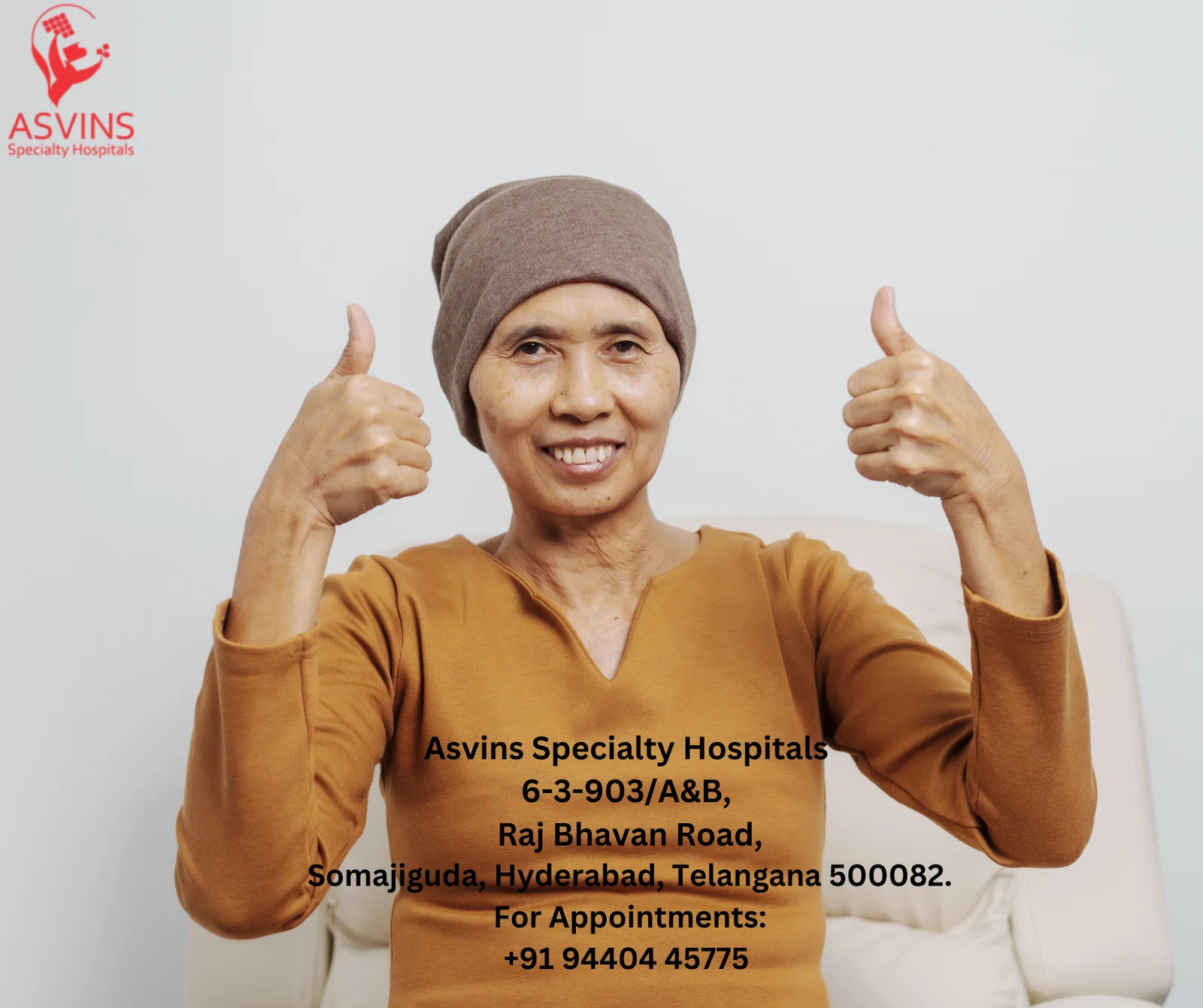
Damage to Healthy Cells: Chemo Treatment drugs target rapidly dividing cells, including not only cancer cells but also healthy cells with high turnover rates. This can lead to damage to tissues such as the lining of the mouth, digestive tract, and bone marrow, causing pain and discomfort.
Inflammation and Mucositis: Chemo Treatment-induced inflammation in the gastrointestinal tract can result in conditions like mucositis, causing painful sores in the mouth and throat.
Nerve Damage: Some Chemo Treatment drugs can cause peripheral neuropathy, leading to pain, tingling, or numbness in the extremities.
Bone Pain: Certain Chemo Treatment drugs may affect the bone marrow, leading to bone pain.
Injection Site Discomfort: Intravenous administration of Chemo Treatment drugs can cause pain at the injection site.
Muscle and Joint Pain: Chemo Treatment may contribute to muscle and joint pain, known as myalgia and arthralgia, respectively.
It’s crucial to communicate any pain or discomfort experienced during Chemo Treatment with the healthcare team. They can provide supportive care, prescribe medications to manage pain, and make adjustments to the treatment plan if necessary. Pain management strategies are an integral part of ensuring the overall well-being and quality of life for individuals undergoing Chemo Treatment.
45. What Are Chemo Treatment After Effects ?What Are Side Effects of Chemo Treatment & Chemo Treatment Drugs ?
Chemo Treatment often leads to side effects, as the drugs not only target cancer cells but may also affect healthy, rapidly dividing cells. Common Chemo Treatment after-effects, or side effects, include:
Nausea and Vomiting: Many Chemo Treatment drugs can irritate the stomach lining, leading to nausea and vomiting.
Fatigue: Chemo Treatment may cause fatigue and weakness, often due to the impact on the bone marrow, where blood cells are produced.
Hair Loss: A well-known side effect, Chemo Treatment can lead to hair loss due to its impact on rapidly dividing hair follicle cells.
Anemia: Chemo Treatment may lower red blood cell counts, causing anemia and resulting in fatigue and weakness.
Neutropenia: A reduction in white blood cells, particularly neutrophils, can weaken the immune system, making individuals more susceptible to infections.
Thrombocytopenia: Reduced platelet counts may lead to bruising and bleeding.
Mucositis: Inflammation of the mucous membranes in the mouth and digestive tract can cause pain and sores.
Peripheral Neuropathy: Nerve damage may result in tingling, numbness, or pain in the extremities.
Changes in Appetite: Chemo Treatment can affect taste and smell, leading to changes in appetite.
Cognitive Changes: Referred to as “chemo brain,” some individuals may experience difficulties with memory and concentration.
These side effects are often temporary and can be managed with supportive care measures, medications, and adjustments to the treatment plan. It’s important for individuals undergoing Chemo Treatment to communicate openly with their healthcare team to address and manage these after-effects effectively.
46. What Are Chemo Treatment After Effects ?
Chemo Treatment can have various after-effects, also known as side effects, which vary depending on the specific drugs used, the type of cancer being treated, and individual patient factors. Common Chemo Treatment after-effects include:
Fatigue: Chemo Treatment can lead to fatigue, which may persist for some time after the completion of treatment. This fatigue is often related to the impact of Chemo Treatment on normal, healthy cells, including those in the bone marrow.
Nausea and Vomiting: Many Chemo Treatment drugs can cause nausea and vomiting during treatment, and these symptoms may continue as after-effects.
Hair Loss: Temporary hair loss is a well-known side effect of Chemo Treatment. Hair typically begins to grow back after the completion of treatment.
Changes in Appetite: Chemo Treatment can affect taste and smell, leading to changes in appetite, including loss of appetite or food aversions.
Cognitive Changes: Some individuals may experience cognitive changes often referred to as “chemo brain,” which can include difficulties with memory, concentration, and mental clarity.
Peripheral Neuropathy: Nerve damage may result in peripheral neuropathy, causing symptoms such as tingling, numbness, or pain in the hands and feet.
Low Blood Counts: Chemo Treatment can lead to low blood cell counts, including red blood cells (anemia), white blood cells (neutropenia), and platelets (thrombocytopenia).
Mucositis: Inflammation of the mucous membranes in the mouth and digestive tract can result in pain, sores, and difficulty swallowing.
It’s important for individuals undergoing Chemo Treatment to be aware of potential after-effects and communicate any symptoms with their healthcare team. Supportive care measures, medications, and lifestyle adjustments can often help manage these after-effects effectively.
1. Chemotherapy Procedure
The chemotherapy procedure involves several key steps aimed at delivering potent anticancer drugs to the body while minimizing side effects:
Assessment and Planning:
Before initiating chemotherapy, the oncologist conducts a comprehensive evaluation, including medical history, physical examination, and diagnostic tests to determine the type, stage, and extent of cancer. Based on this assessment, a personalized chemotherapy regimen is devised.
Drug Selection:
Chemotherapy drugs are selected based on the type and stage of cancer, as well as the patient’s overall health. Different drugs or combinations may be used to achieve the desired therapeutic effect.
Administration:
Chemotherapy drugs can be administered through various routes, including intravenous (IV) infusion, oral medications, injections, or topical applications. The method of administration depends on factors such as the specific drugs used, treatment goals, and patient preferences.
Treatment Cycles:
Chemotherapy is typically administered in cycles, with each cycle consisting of a period of treatment followed by a rest period to allow the body to recover. The frequency and duration of cycles vary depending on the chemotherapy regimen and the individual’s response to treatment.
Monitoring and Supportive Care:
Throughout chemotherapy, patients are closely monitored for side effects, and supportive care measures are provided to manage symptoms and improve quality of life. This may include medications to alleviate nausea, fatigue, and pain, as well as nutritional support and psychological counseling.
Response Evaluation:
Periodic assessments, such as imaging scans and blood tests, are conducted to evaluate the response to chemotherapy and make any necessary adjustments to the treatment plan.
Follow-Up:
After completing chemotherapy, patients undergo regular follow-up appointments to monitor for recurrence, manage any long-term side effects, and provide ongoing support and care.
2. Cancer Treatment Drugs
Cancer treatment drugs, also known as anticancer or chemotherapy drugs, play a vital role in combating cancer by targeting and destroying cancer cells or impeding their growth. These drugs are designed to disrupt the abnormal cellular processes characteristic of cancer cells while minimizing damage to healthy cells. There are several types of cancer treatment drugs, each with distinct mechanisms of action and applications:
Cytotoxic Drugs:
These drugs work by directly damaging the DNA or interfering with the cell division process, leading to the death of rapidly dividing cancer cells. Examples include alkylating agents, antimetabolites, and plant alkaloids.
Targeted Therapy:
Targeted drugs selectively target specific molecules or pathways involved in cancer growth and progression. They aim to block the signals that promote cancer cell growth and survival. Examples include monoclonal antibodies, tyrosine kinase inhibitors, and hormone therapies.
Immunotherapy:
Immunotherapy drugs harness the body’s immune system to recognize and destroy cancer cells. They enhance the immune response against cancer by stimulating the immune system or removing the barriers that prevent immune cells from recognizing cancer cells.
Hormonal Therapy:
Hormonal drugs interfere with the hormones that promote the growth of certain types of cancers, such as breast and prostate cancers. They work by blocking hormone receptors on cancer cells or reducing hormone production in the body.
Angiogenesis Inhibitors:
These drugs target the process of angiogenesis, which is the formation of new blood vessels that supply oxygen and nutrients to tumors. By inhibiting angiogenesis, these drugs deprive tumors of their blood supply, hindering their growth and spread.
Each type of cancer treatment drug has its indications, side effects, and efficacy, and their use is often tailored to the specific type and stage of cancer, as well as individual patient factors. Combination therapies involving multiple drugs or modalities are frequently employed to optimize treatment outcomes and minimize resistance. Ongoing research and development in the field of cancer treatment drugs continue to expand the arsenal of available therapies and improve outcomes for cancer patients.
3. 1st Chemo Treatment Side Effects
The side effects of the first chemotherapy treatment can vary widely among individuals and depend on factors such as the type and dosage of chemotherapy drugs used, the specific cancer being treated, and the patient’s overall health. However, common side effects experienced after the first chemotherapy treatment may include:
Nausea and Vomiting:
Chemotherapy drugs can irritate the lining of the stomach, leading to nausea and vomiting shortly after treatment.
Fatigue:
Many patients experience fatigue or tiredness after chemotherapy, which can be due to the impact of treatment on the body’s normal cells, including those in the bone marrow.
Hair Loss:
Chemotherapy-induced hair loss, or alopecia, is a well-known side effect that often begins a few weeks after treatment initiation.
Low Blood Cell Counts:
Chemotherapy can reduce the production of blood cells in the bone marrow, leading to low red blood cell counts (anemia), low white blood cell counts (neutropenia), and low platelet counts (thrombocytopenia). These can increase the risk of infections, bleeding, and fatigue.
Mouth Sores:
Chemotherapy can cause inflammation and sores in the mouth and throat, making it painful to eat, drink, or swallow.
Changes in Appetite:
Some patients may experience changes in appetite, including loss of appetite or taste changes.
It’s important for patients to communicate any side effects experienced after their first chemotherapy treatment with their healthcare team. Supportive care measures, including medications, dietary modifications, and lifestyle adjustments, can often help manage these symptoms effectively.
4. C hemo Cancer
Chemotherapy, often abbreviated as “chemo,” is a cornerstone of cancer treatment, encompassing a diverse array of drugs designed to combat cancer cells. This systemic therapy works by targeting rapidly dividing cells throughout the body, including cancerous cells, with the goal of destroying or inhibiting their growth. Chemotherapy drugs may be administered orally, intravenously, or through other routes, depending on the specific cancer type, stage, and treatment plan.
While chemotherapy is effective in killing cancer cells, it can also affect normal, healthy cells with high turnover rates, leading to a range of side effects. These may include nausea, vomiting, fatigue, hair loss, and changes in blood cell counts. Despite its challenges, chemotherapy has significantly improved cancer outcomes and survival rates for many patients.
Chemotherapy is often utilized in combination with other treatment modalities, such as surgery, radiation therapy, targeted therapy, and immunotherapy, as part of a multidisciplinary approach to cancer care. The selection and sequencing of chemotherapy drugs are tailored to the individual patient’s needs, considering factors like cancer type, stage, and overall health.
Ongoing research and advancements in chemotherapy continue to expand the repertoire of available drugs and refine treatment strategies, aiming to enhance efficacy while minimizing side effects. Overall, chemotherapy remains a critical tool in the fight against cancer, offering hope and improved quality of life for countless individuals worldwide.
5. Cancer Treatment Chemotherapy
Chemotherapy is a cornerstone of cancer treatment, employing potent drugs to combat cancer cells and halt their growth or spread. This systemic therapy targets rapidly dividing cells throughout the body, including cancerous cells, with the aim of eradicating or suppressing their proliferation. Chemotherapy drugs may be administered via various routes, including oral ingestion, intravenous infusion, injections, or topical applications, depending on factors such as cancer type, stage, and treatment goals.
While chemotherapy effectively targets cancer cells, it can also affect healthy cells with high turnover rates, leading to a range of side effects. Despite these challenges, chemotherapy has significantly improved cancer outcomes and survival rates for many patients across different cancer types.
Chemotherapy is often employed in combination with other treatment modalities, including surgery, radiation therapy, targeted therapy, and immunotherapy, as part of a comprehensive cancer management strategy. The selection and sequencing of chemotherapy drugs are personalized to each patient’s specific needs, considering factors such as cancer subtype, stage, and overall health.
Ongoing research and advancements in chemotherapy continue to refine treatment approaches, aiming to enhance efficacy, reduce side effects, and improve patient outcomes. Despite its complexities, chemotherapy remains a vital component of cancer care, offering hope and life-saving benefits to millions of individuals worldwide battling cancer.
Asvins Speciality Hospital in Hyderabad offers expert cancer care, including R-DHAP chemotherapy. At Asvins Speciality Hospital, we specialize in providing advanced chemotherapy …
Asvins Speciality Hospital in Hyderabad offers affordable and effective cancer care, including oral chemotherapy costs in India. Chemotherapy is an important treatment …
Chemotherapy Nursing Care Plan Expert Cancer Care at Asvins Speciality Hospital in Hyderabad Chemotherapy is an important part of cancer treatment, but …
கீமோதிரபி சிகிச்சை - அஸ்வின்ஸ் ஸ்பெஷாலிட்டி ஹாஸ்பிடல், ஹைதராபாத் புற்றுநோயால் பாதிக்கப்பட்டவர்களுக்கு கீமோதிரபி சிகிச்சை மிகவும் முக்கியமான ஒன்றாகும். இது புற்றுநோய் செல்களை அழித்து, அவற்றின் வளர்ச்சியை கட்டுப்படுத்த உதவுகிறது. …
Chemotherapy Cost in Kolkata vs. Chemotherapy Cost in Hyderabad Chemotherapy is vital in cancer treatment since it enables patients to fight and …
Chemotherapy Cost in Bangalore vs. Chemotherapy Cost in Hyderabad Chemotherapy is an important part of cancer treatment, and the cost varies greatly …
Asvins Speciality Hospital's Baxter Pump Chemotherapy One of the most effective cancer therapies is chemotherapy, which fights cancerous cells with potent medications. …
The cost of chemotherapy for breast cancer in India One of the most common cancers in women, breast cancer, requires chemotherapy to …
केमोथेरपीचे दुष्परिणाम - अस्विन्स स्पेशालिटी हॉस्पिटल केमोथेरपी हा कर्करोग उपचारांसाठी एक प्रभावी पर्याय आहे, ज्याचा उपयोग कर्करोगाच्या पेशींना नष्ट करण्यासाठी केला जातो. …
The cost of chemotherapy in Hyderabad Hyderabad is known for being a top location for high-quality medical care, including cutting-edge cancer therapies …
Expert EC Chemotherapy for Breast Cancer Treatment at Asvins Speciality Hospital We at Asvins Speciality Hospital offer EC Chemotherapy, a highly effective …
Chemotherapy Nursing Diagnosis: All-Inclusive Care at Asvins Speciality Hospital Chemotherapy is an essential but difficult part of cancer treatment, and we at …



